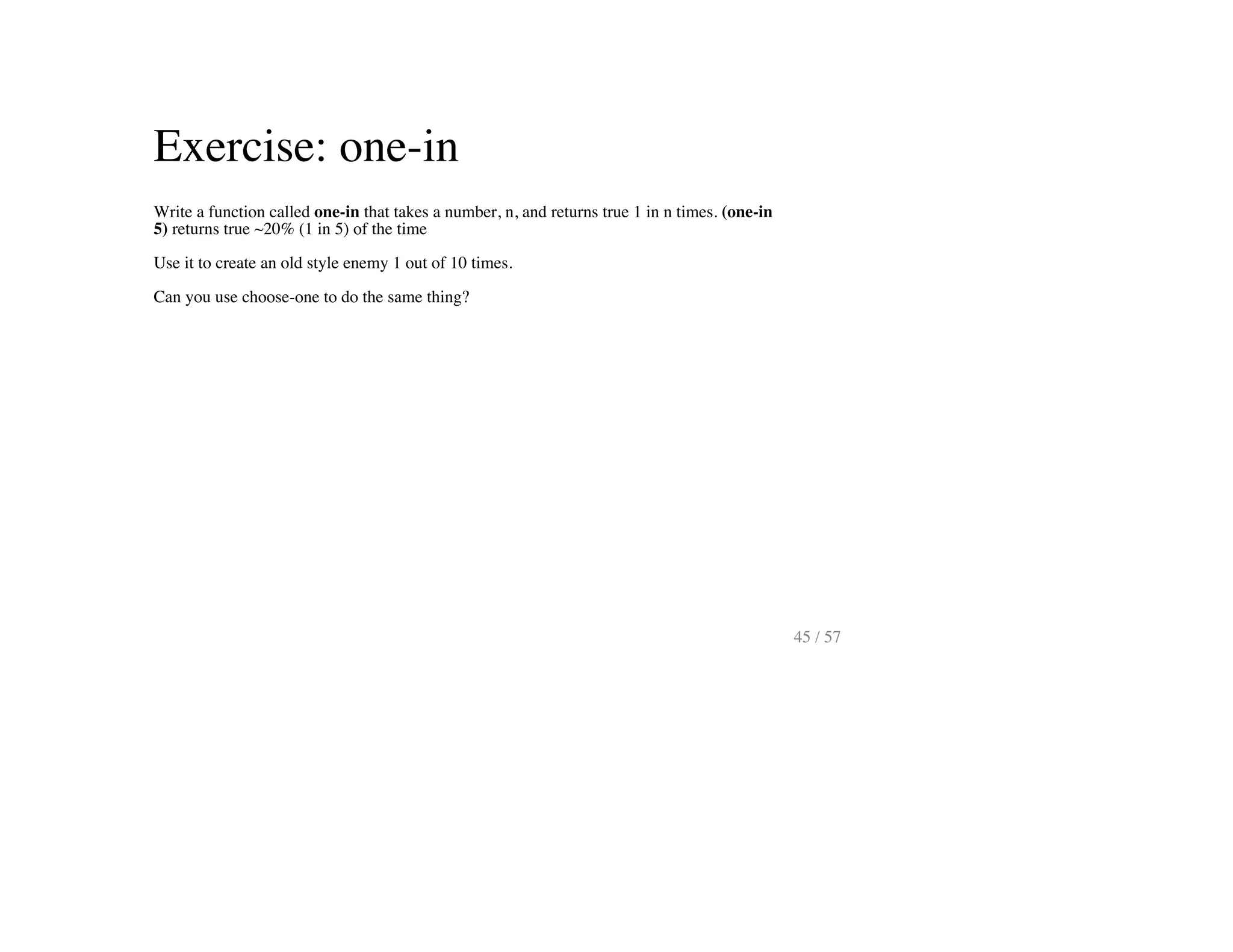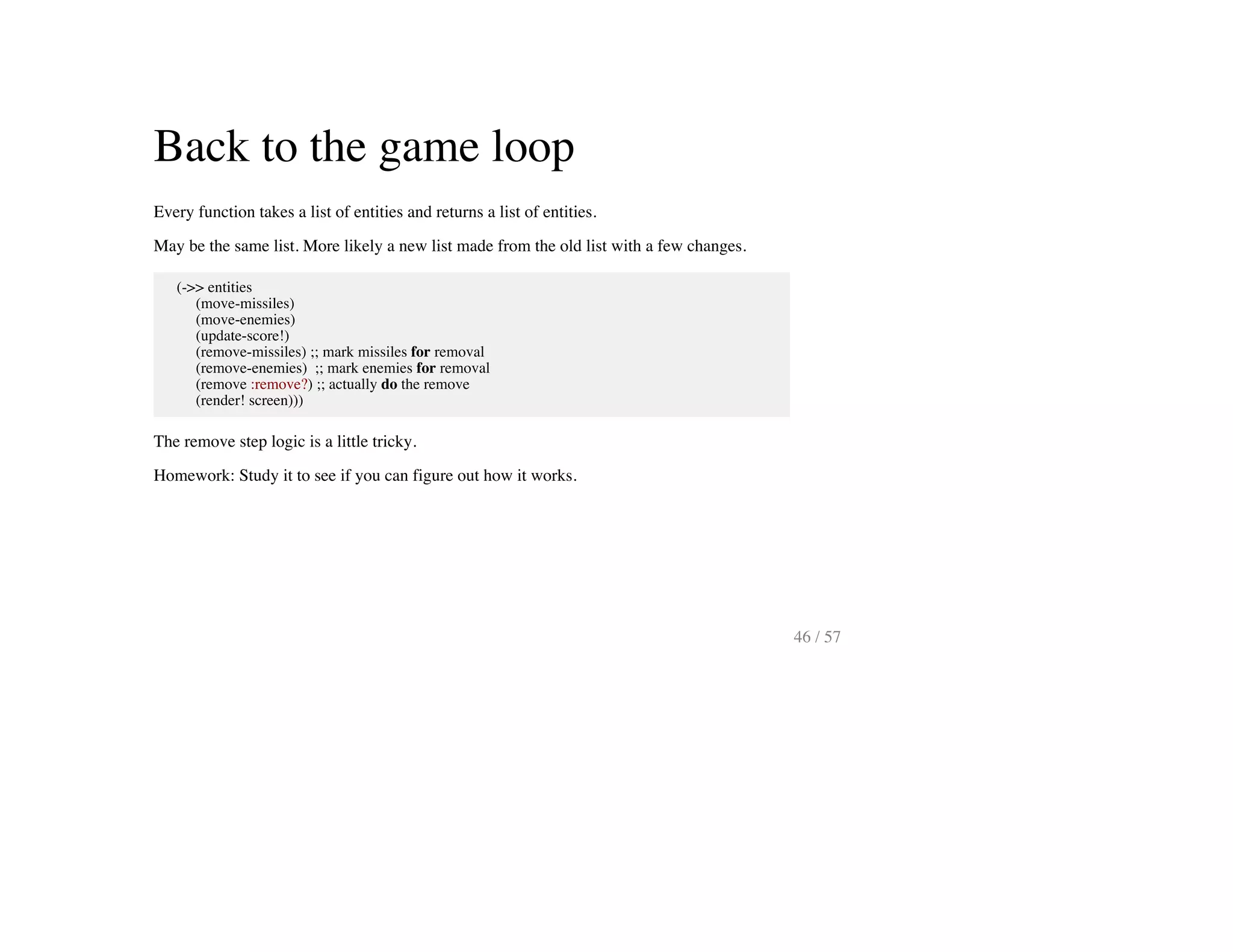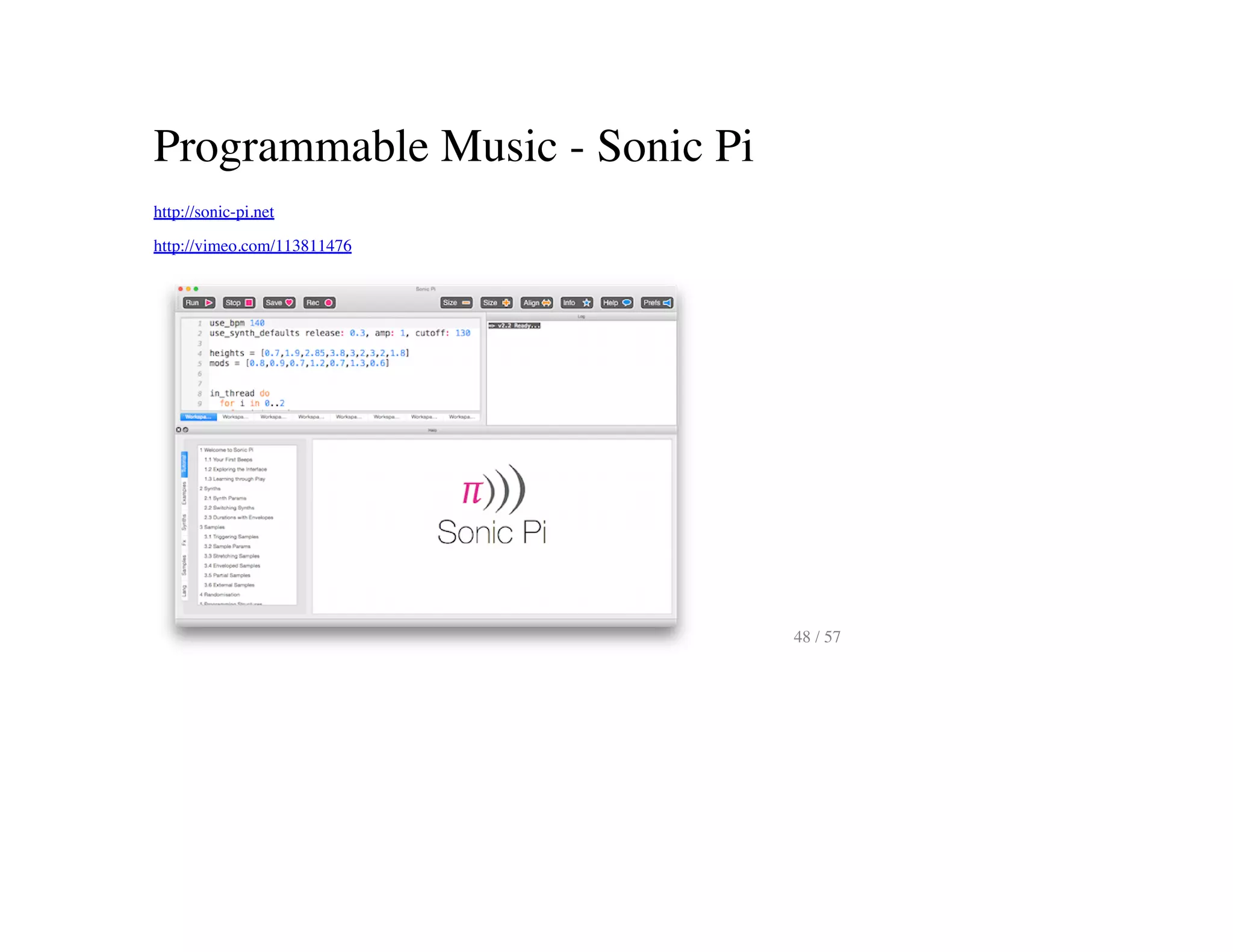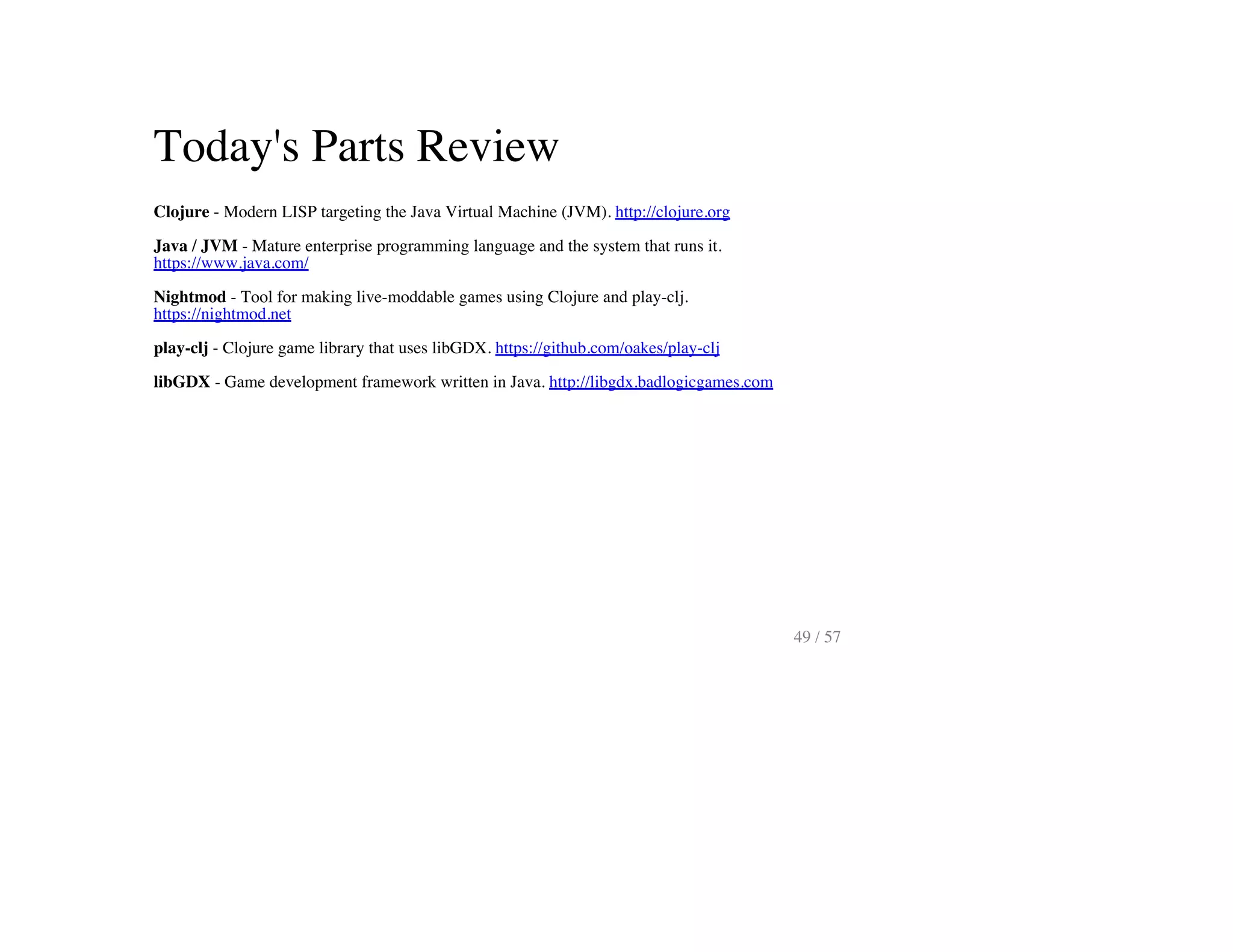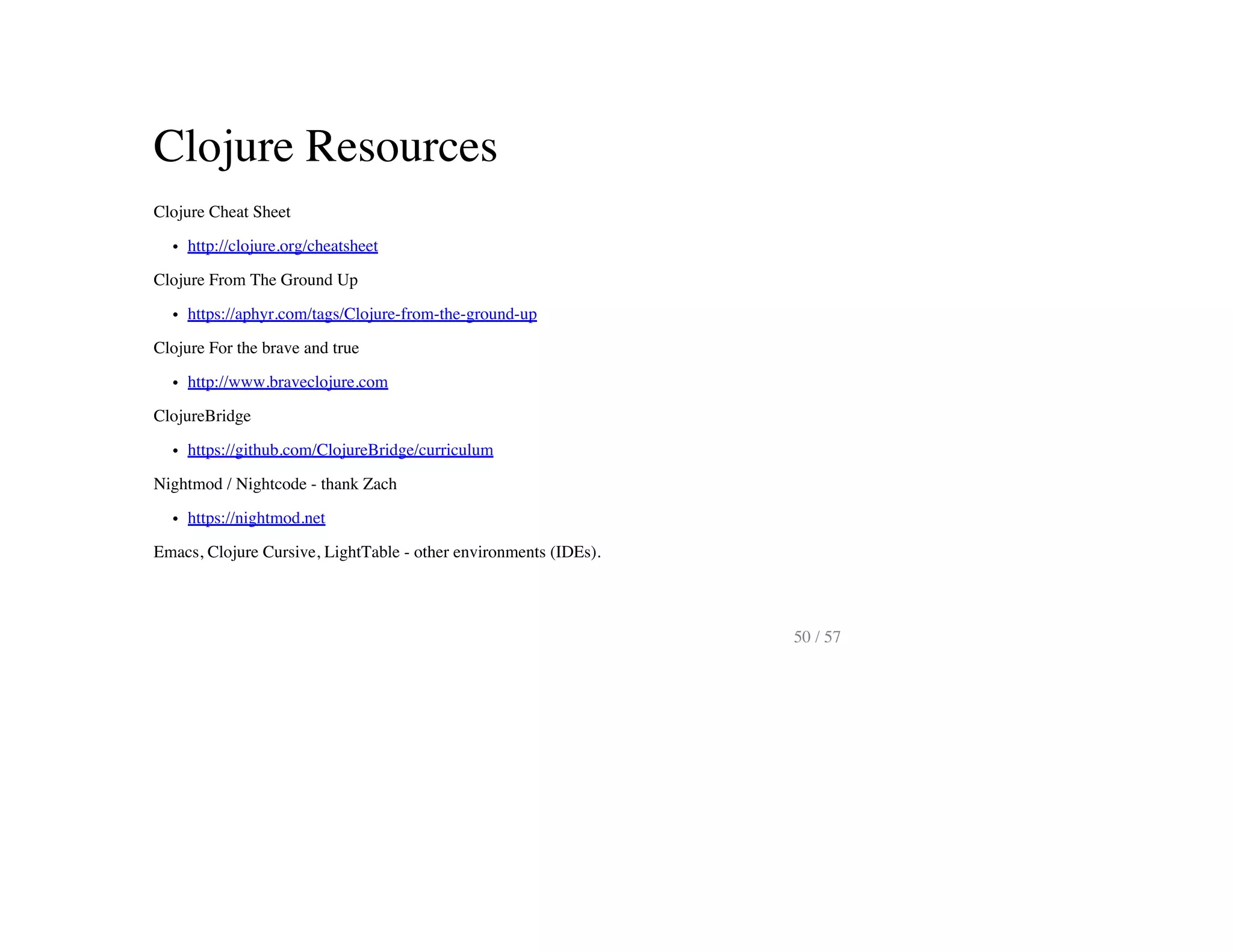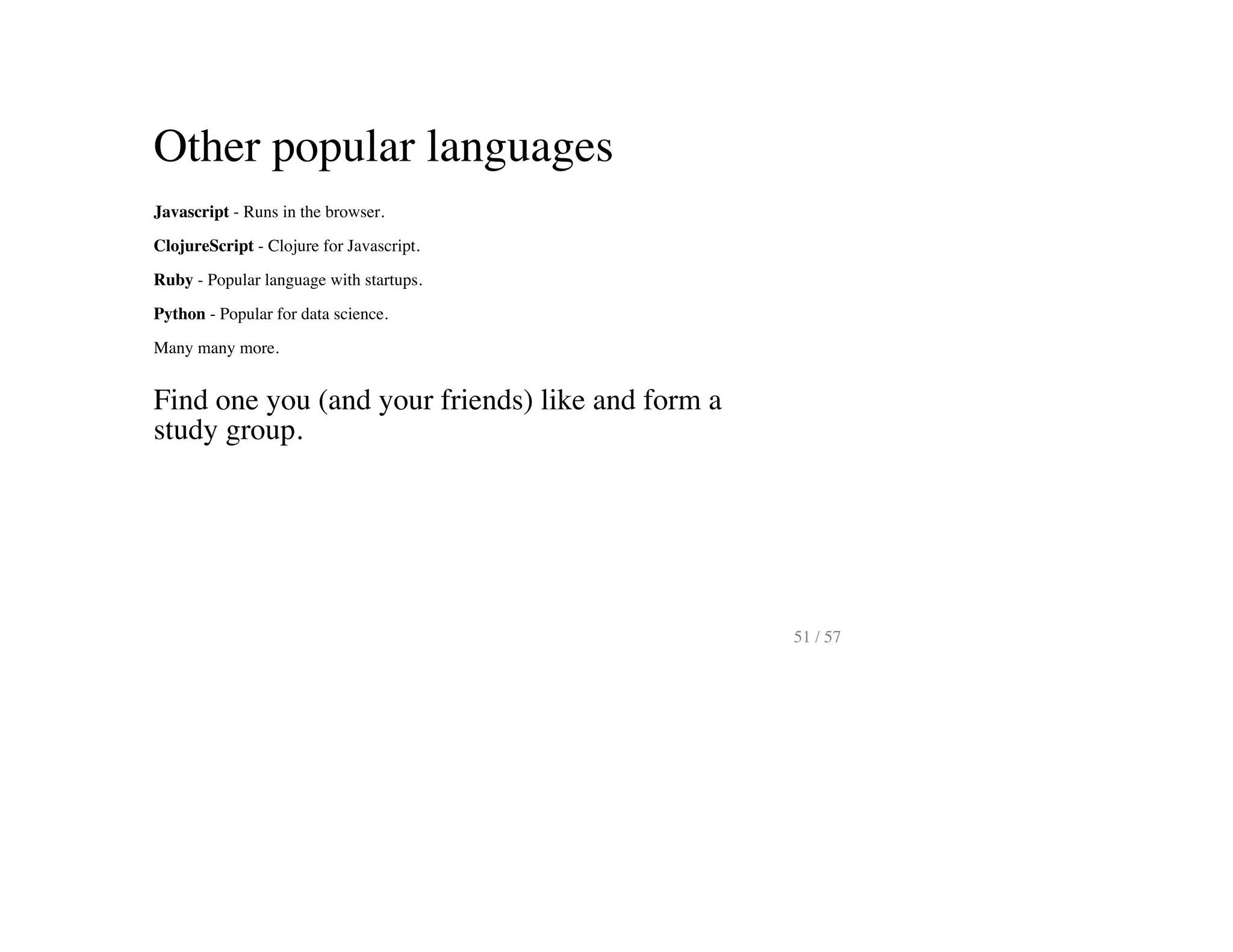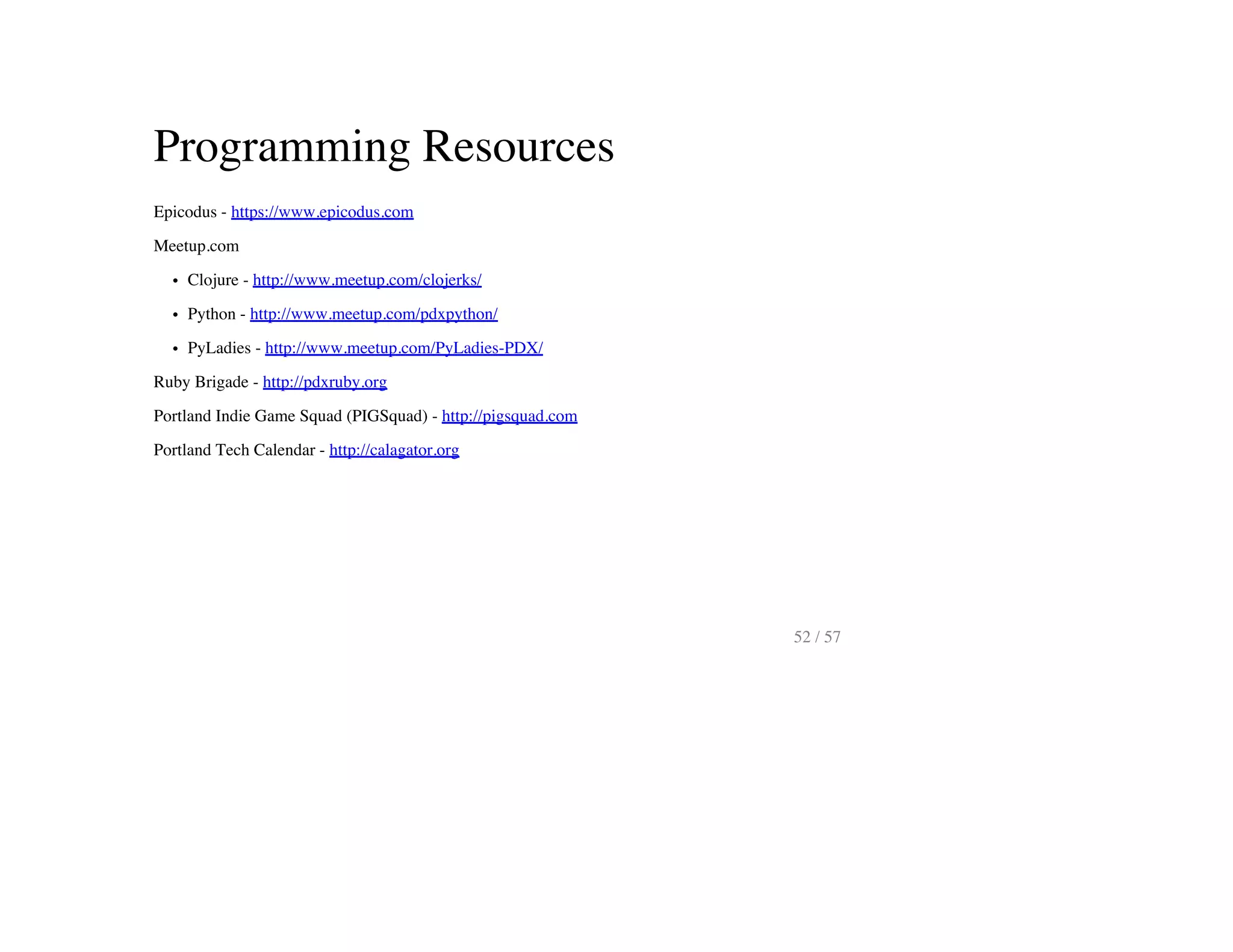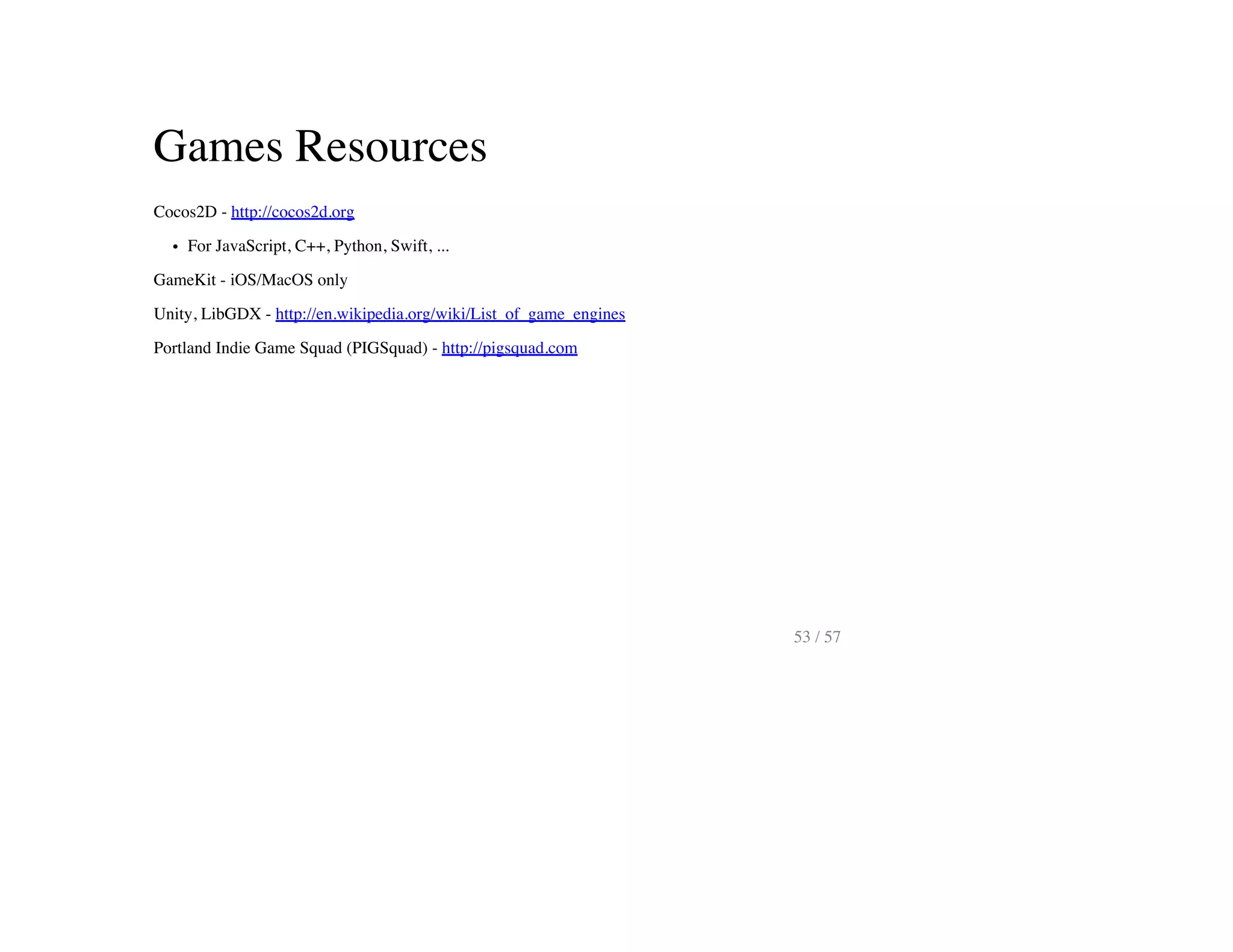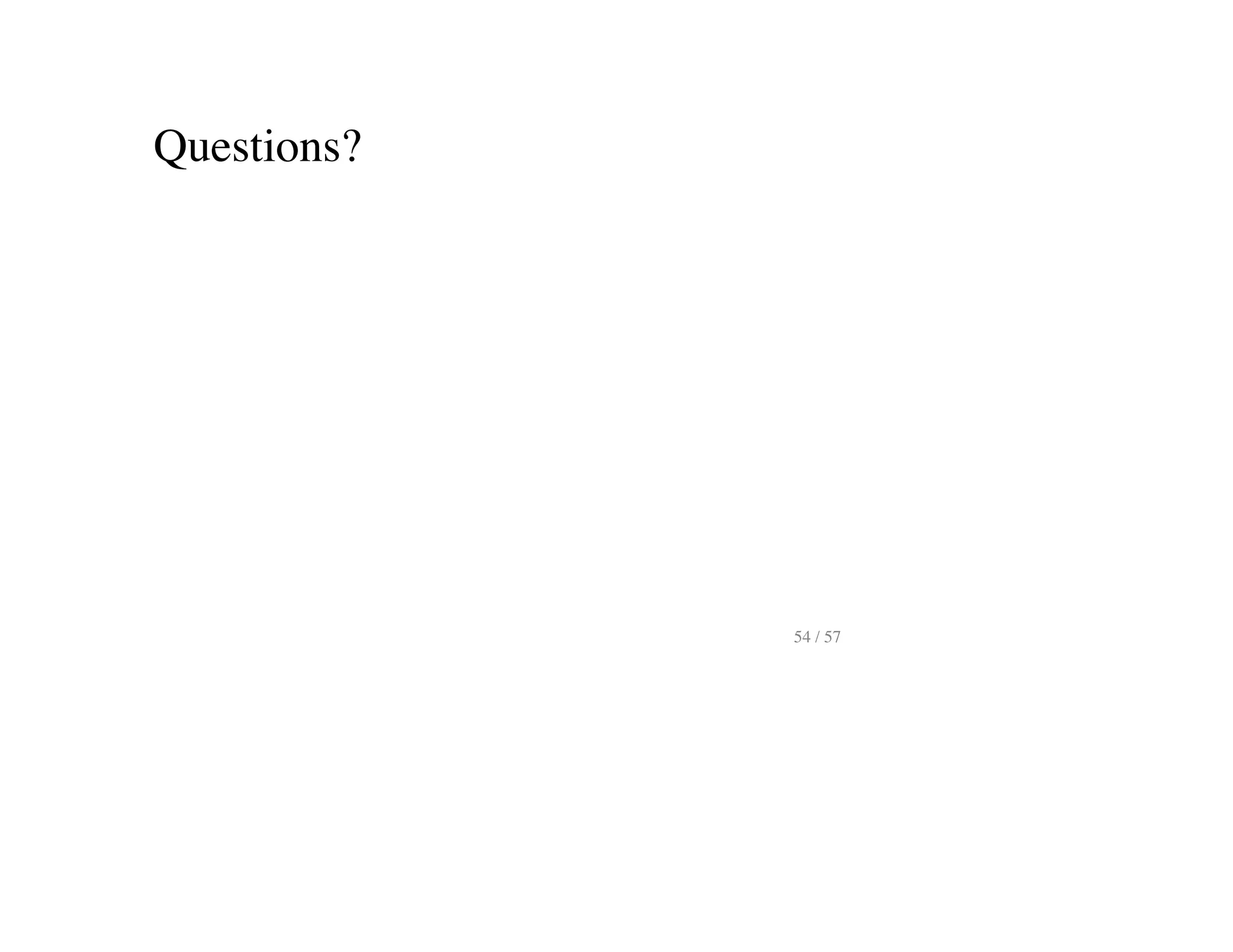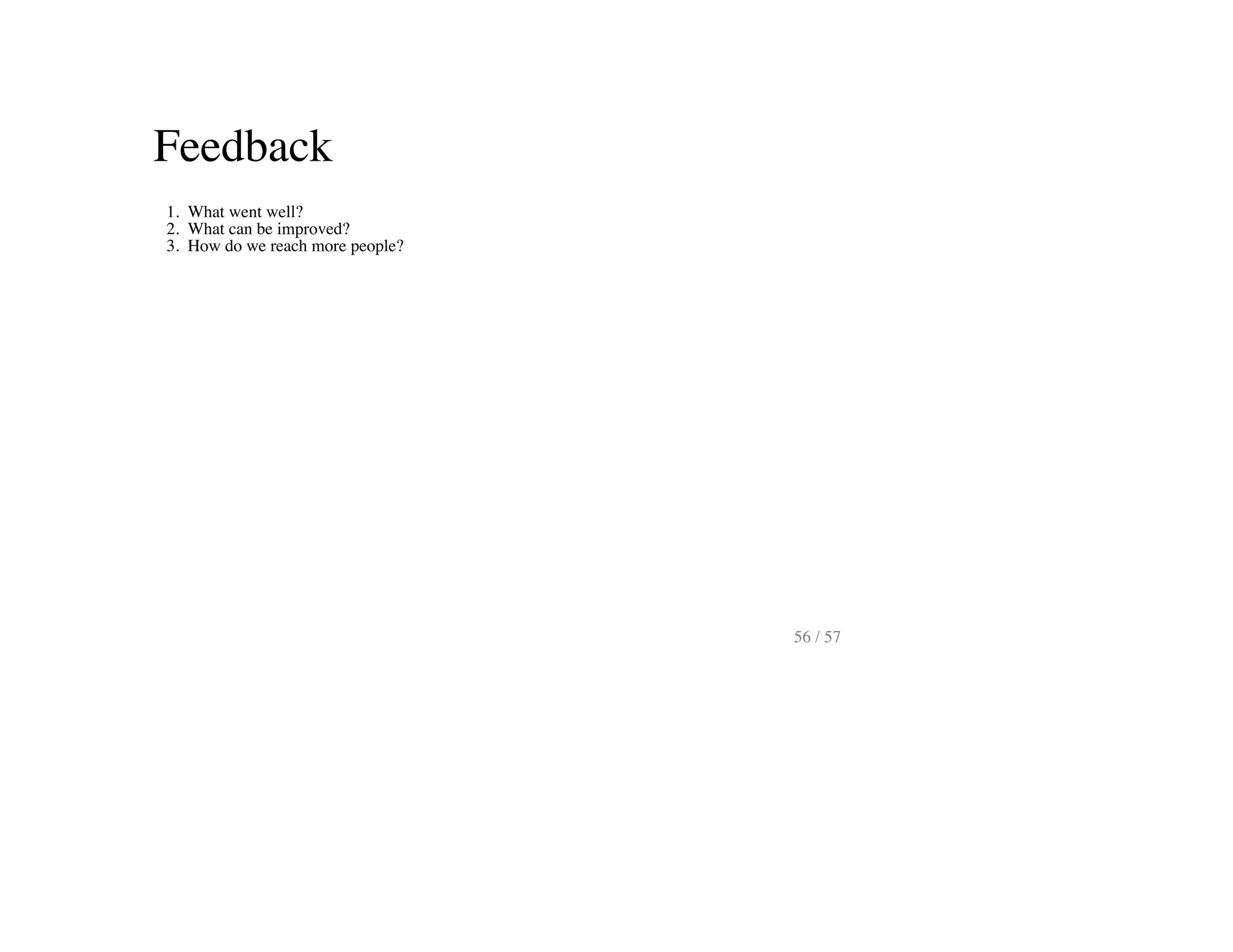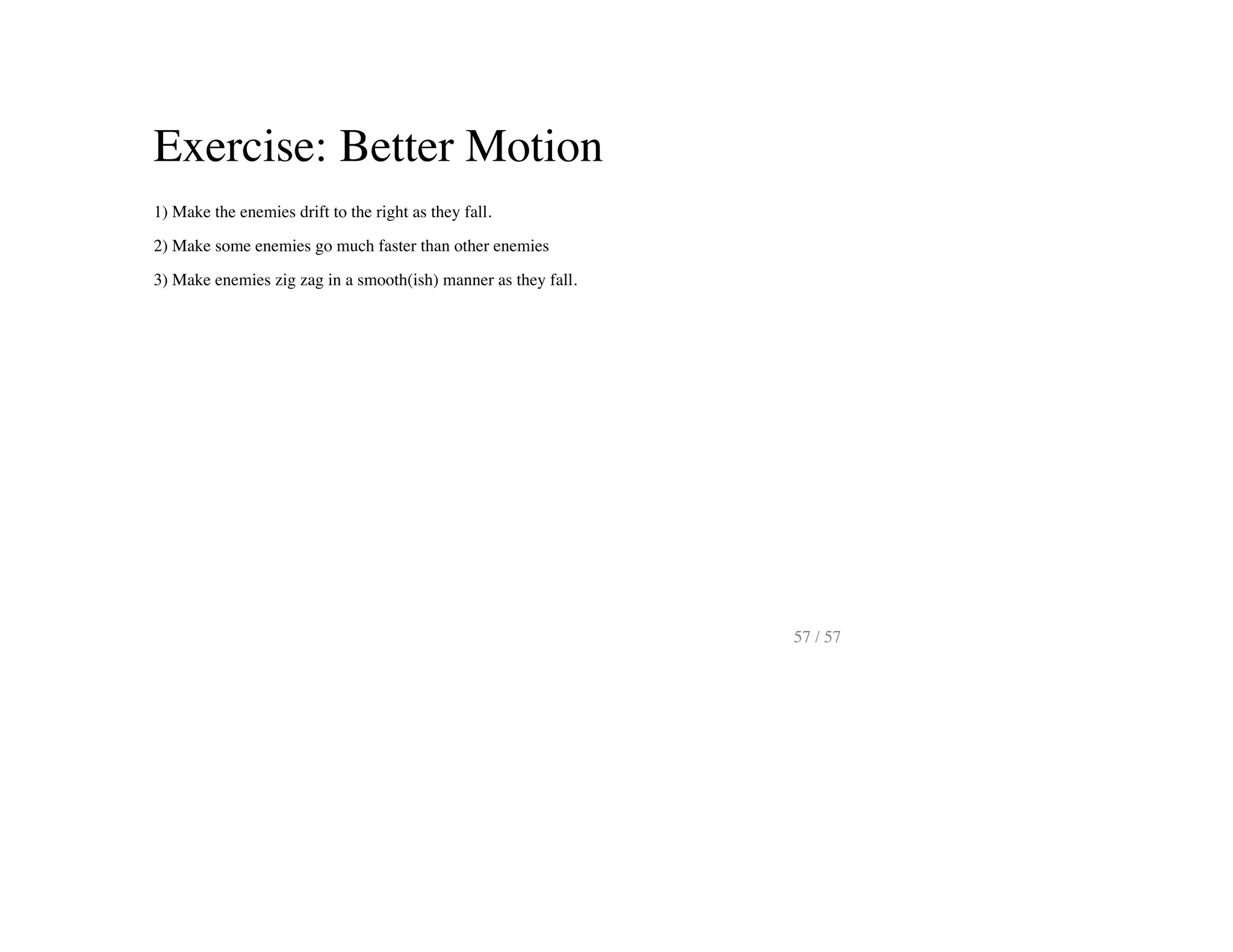This document is a tutorial on programming games using Clojure, guiding users through creating a simple game with hands-on modifications. It covers concepts related to game development, including creating and modifying players and enemies, incorporating sound, and understanding game loops and data structures in Clojure. Additionally, it provides resources for further learning and programming community engagement.
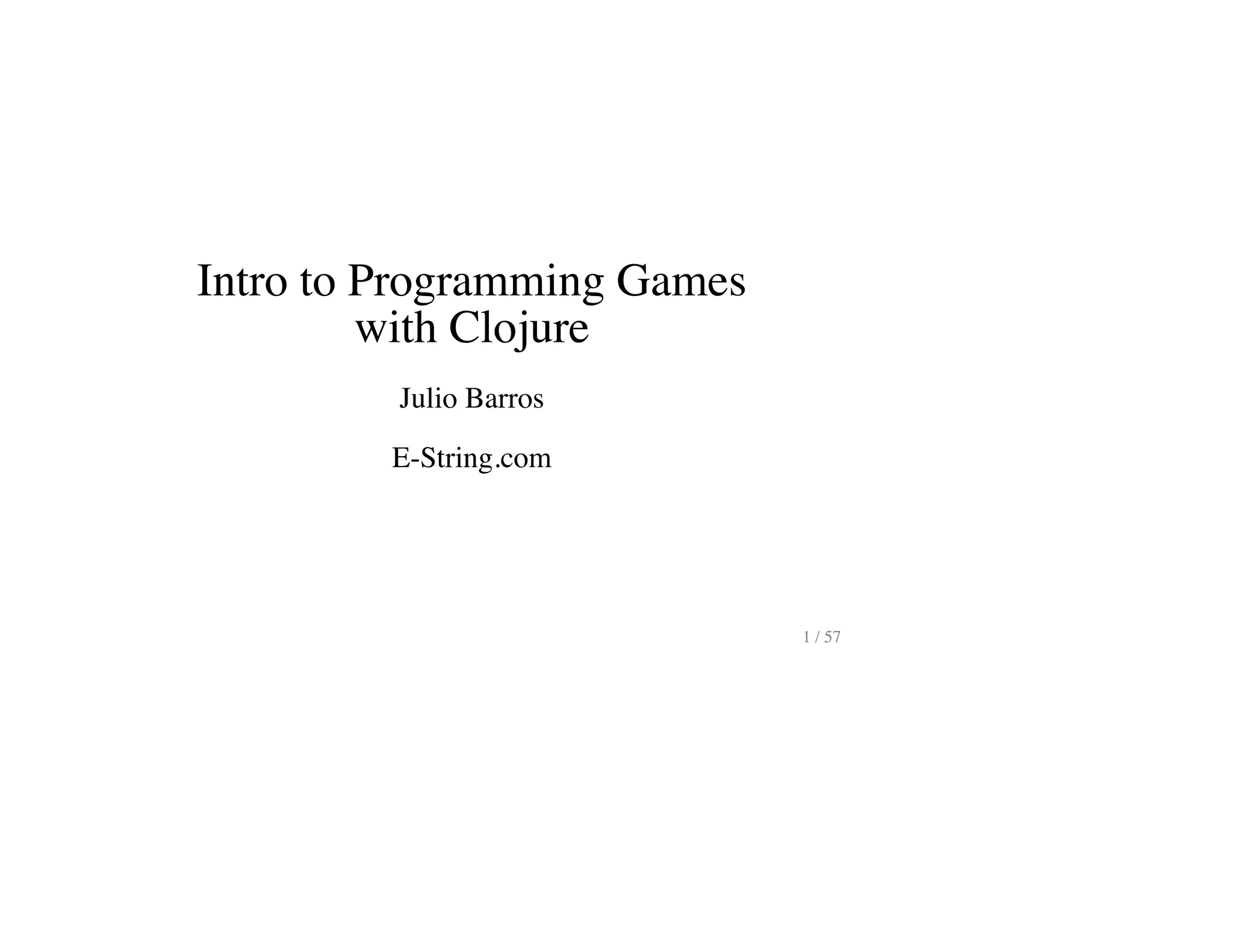
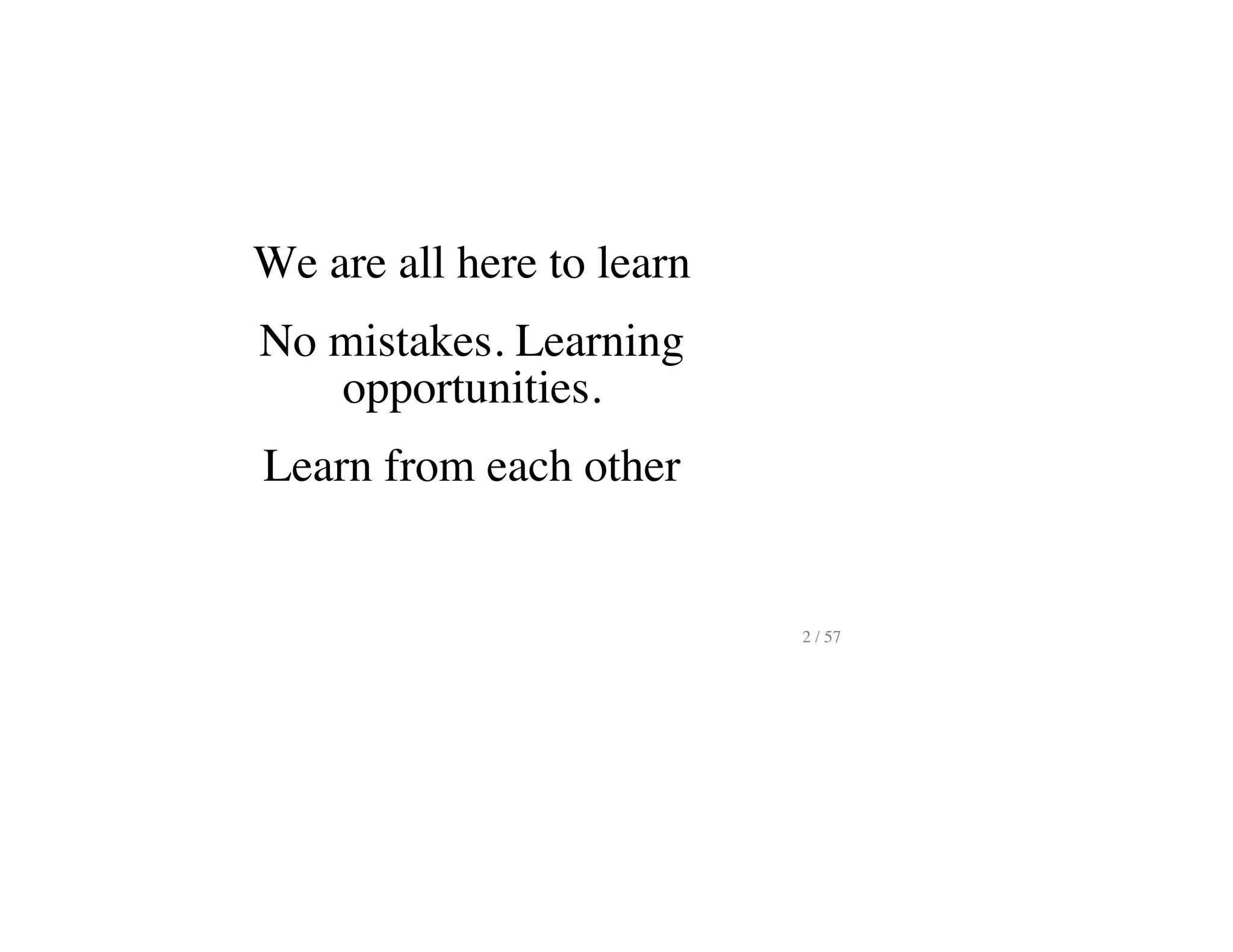
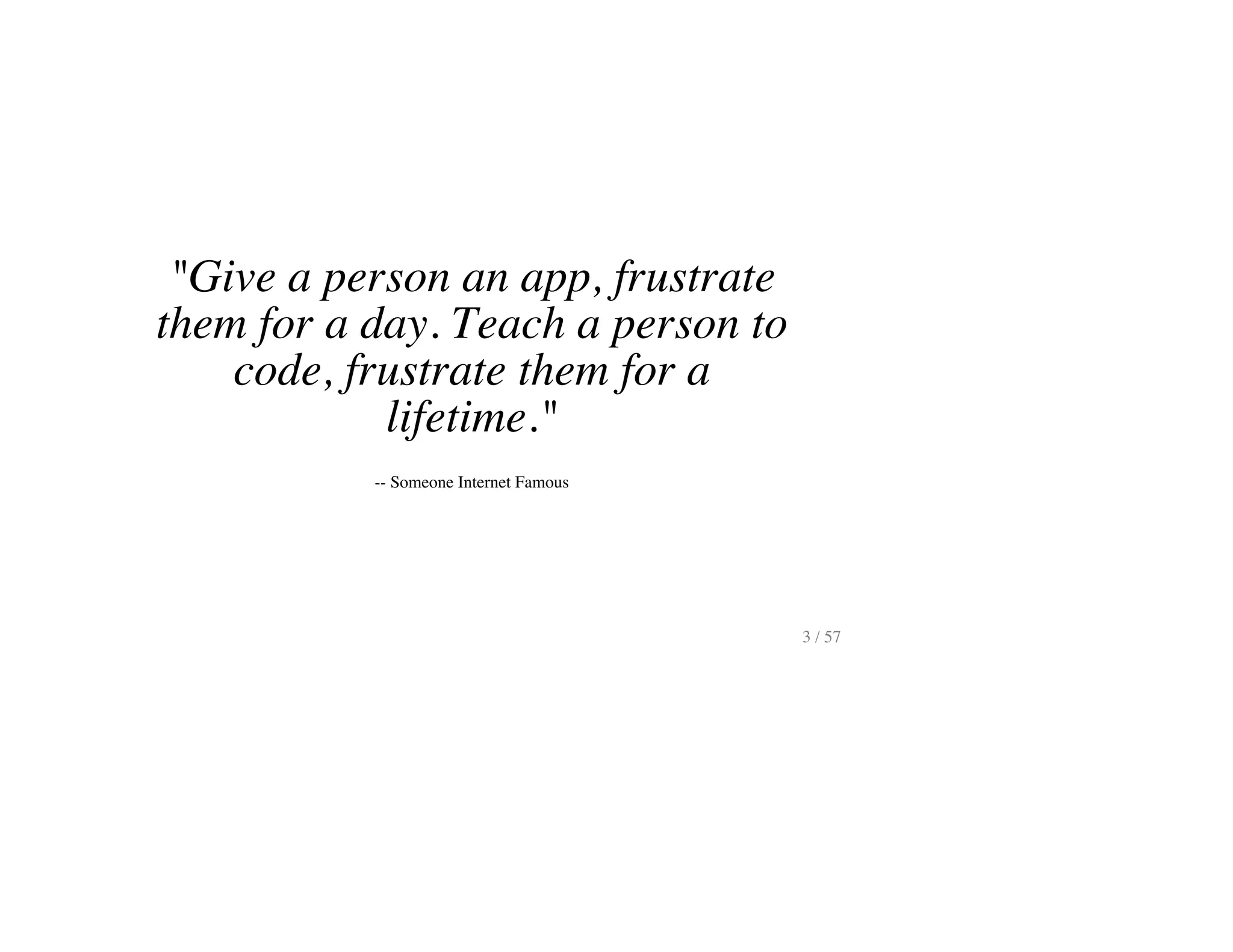
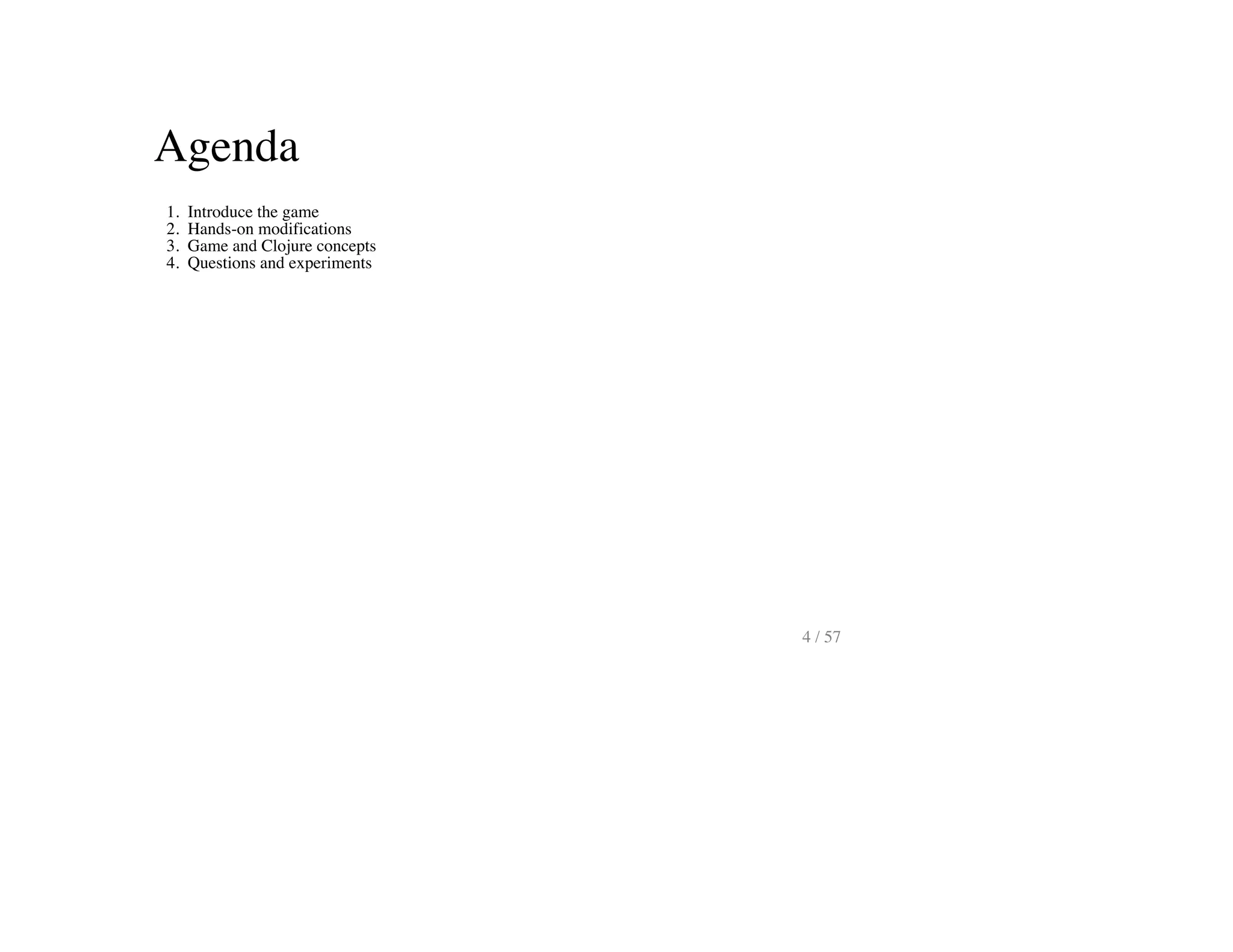
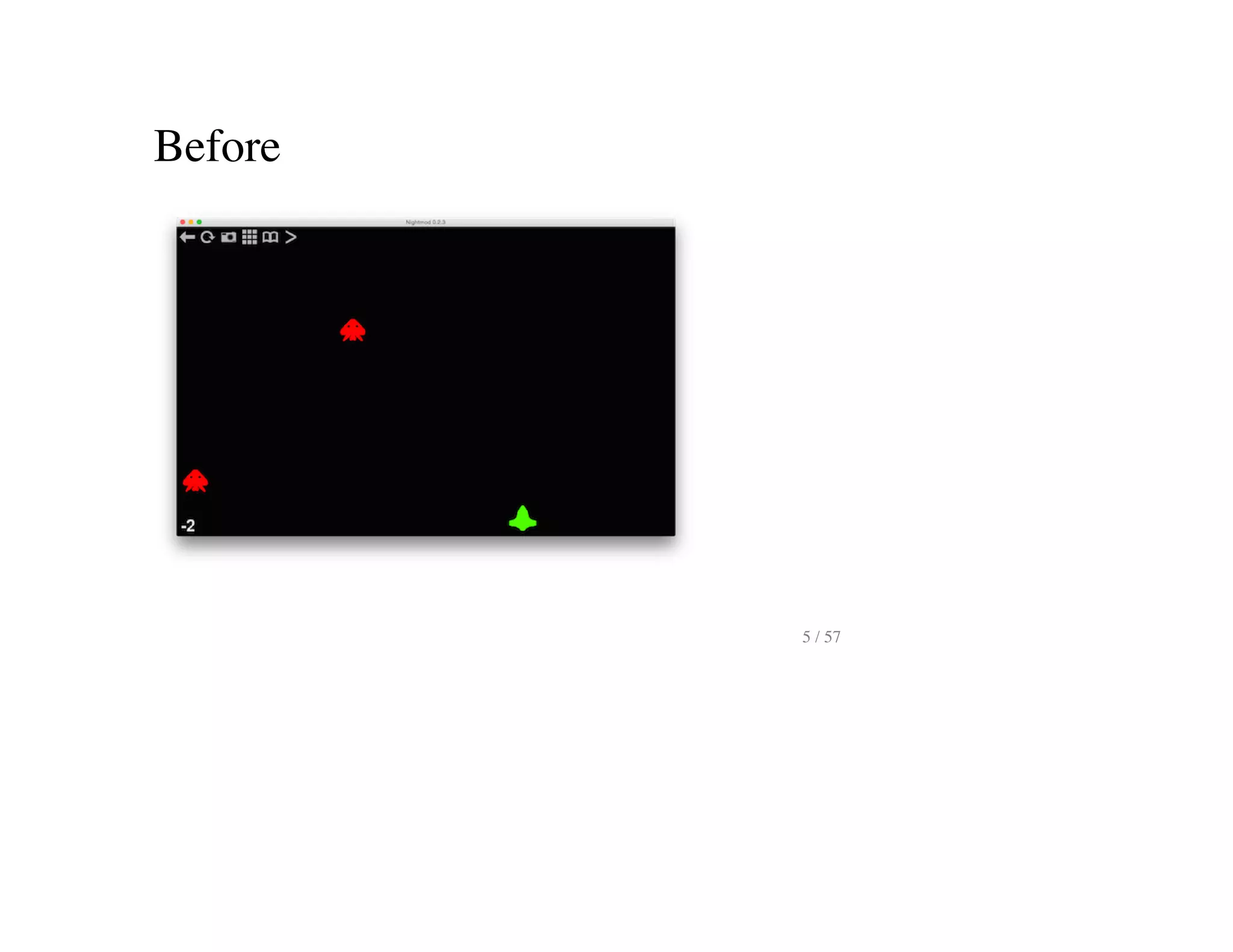
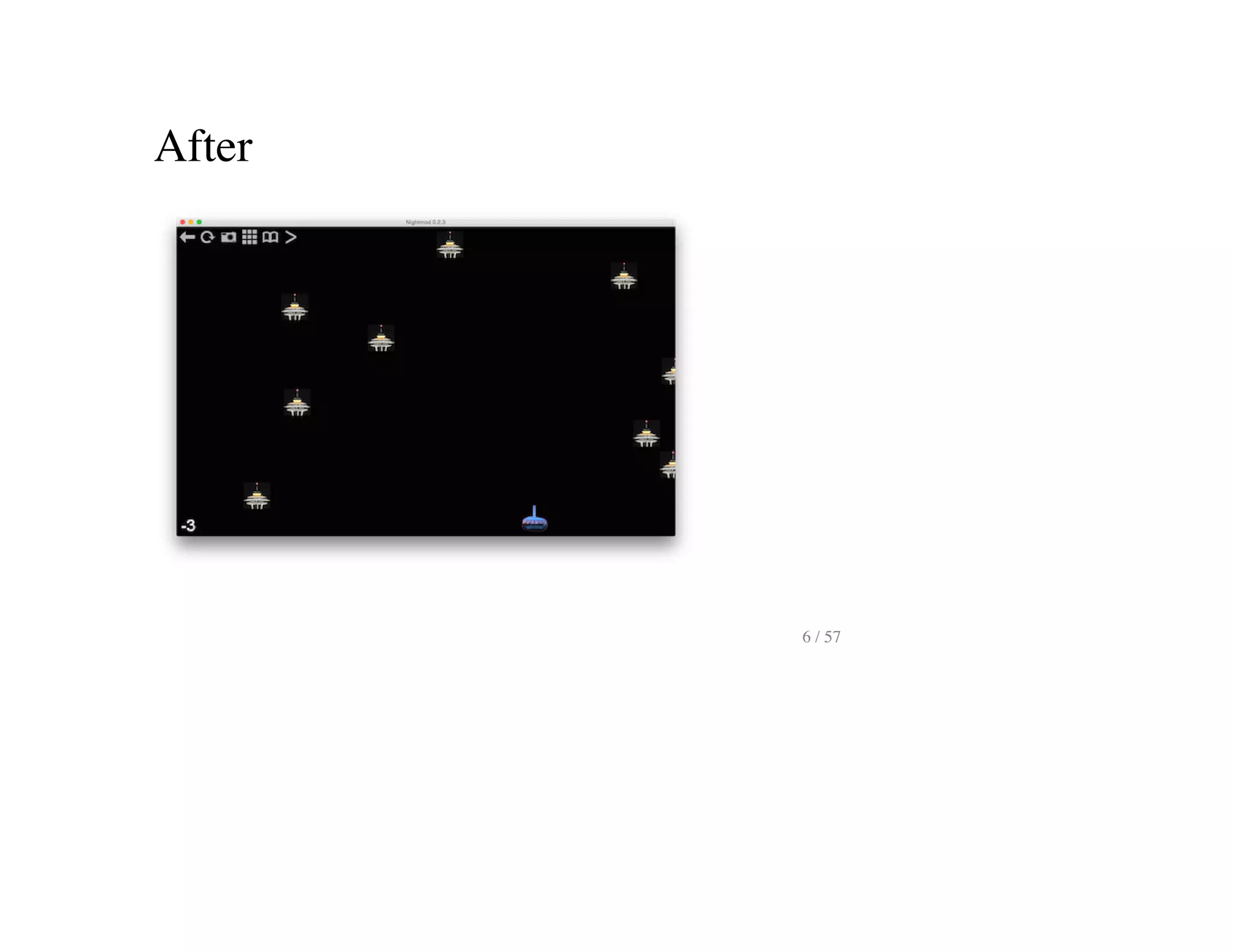
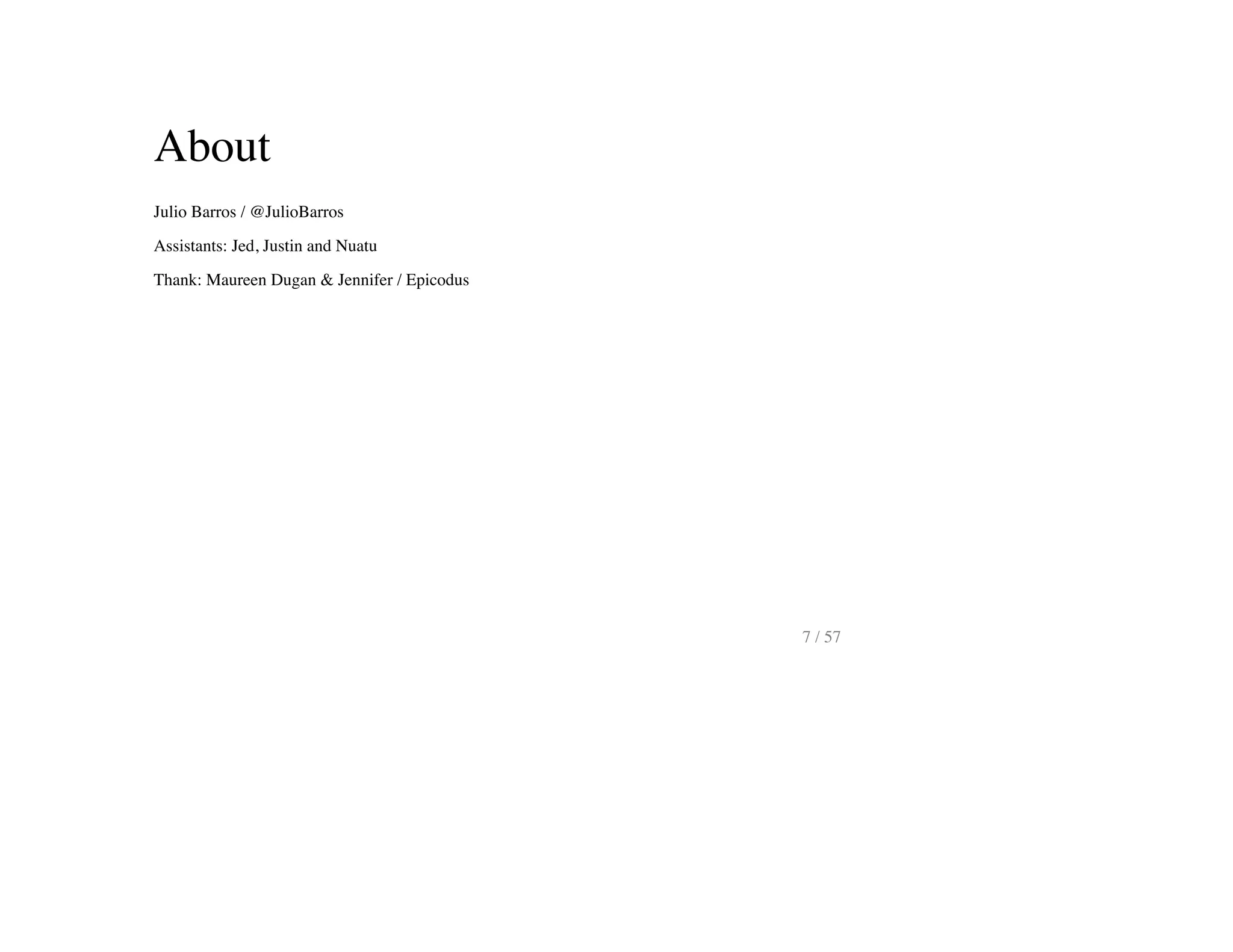
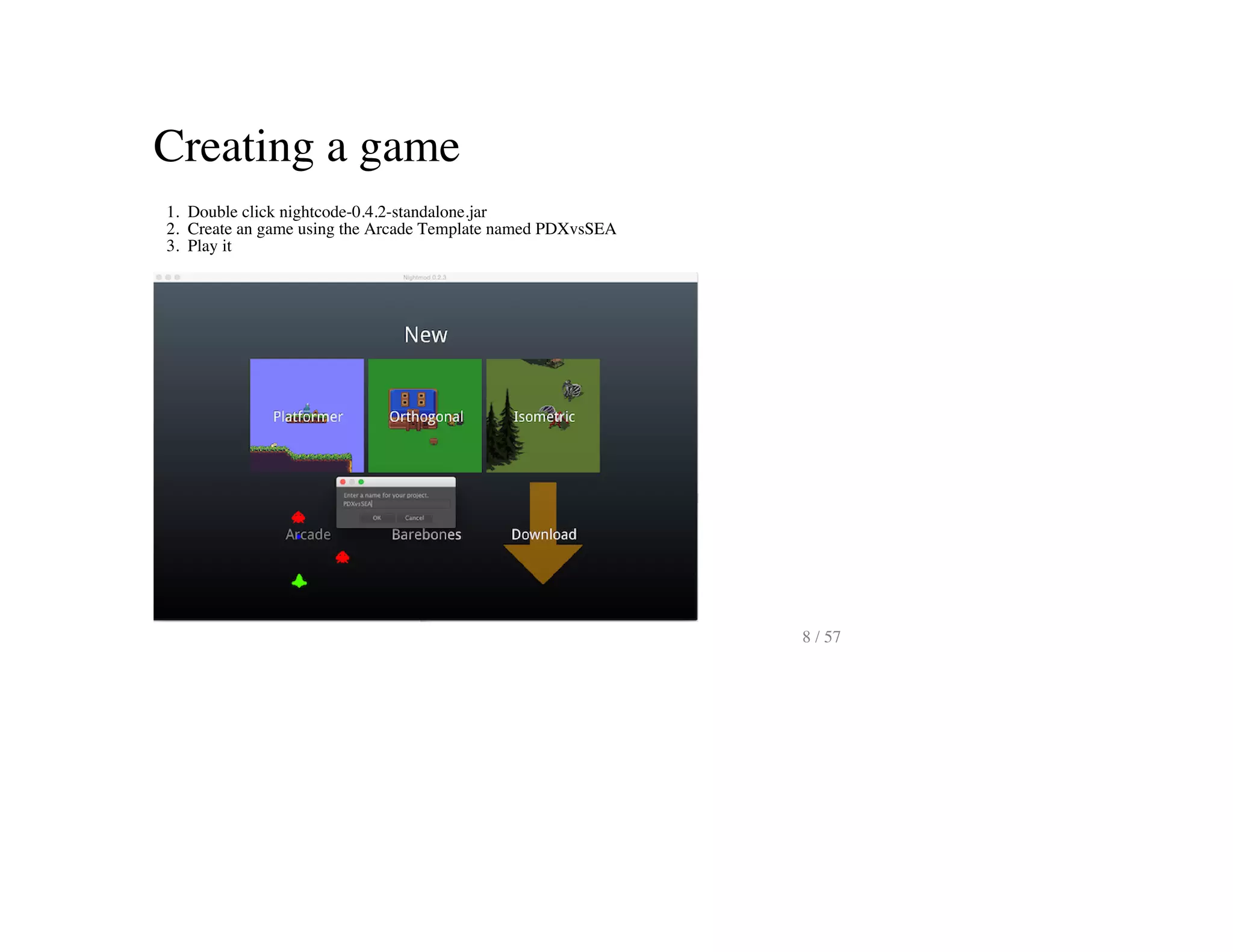
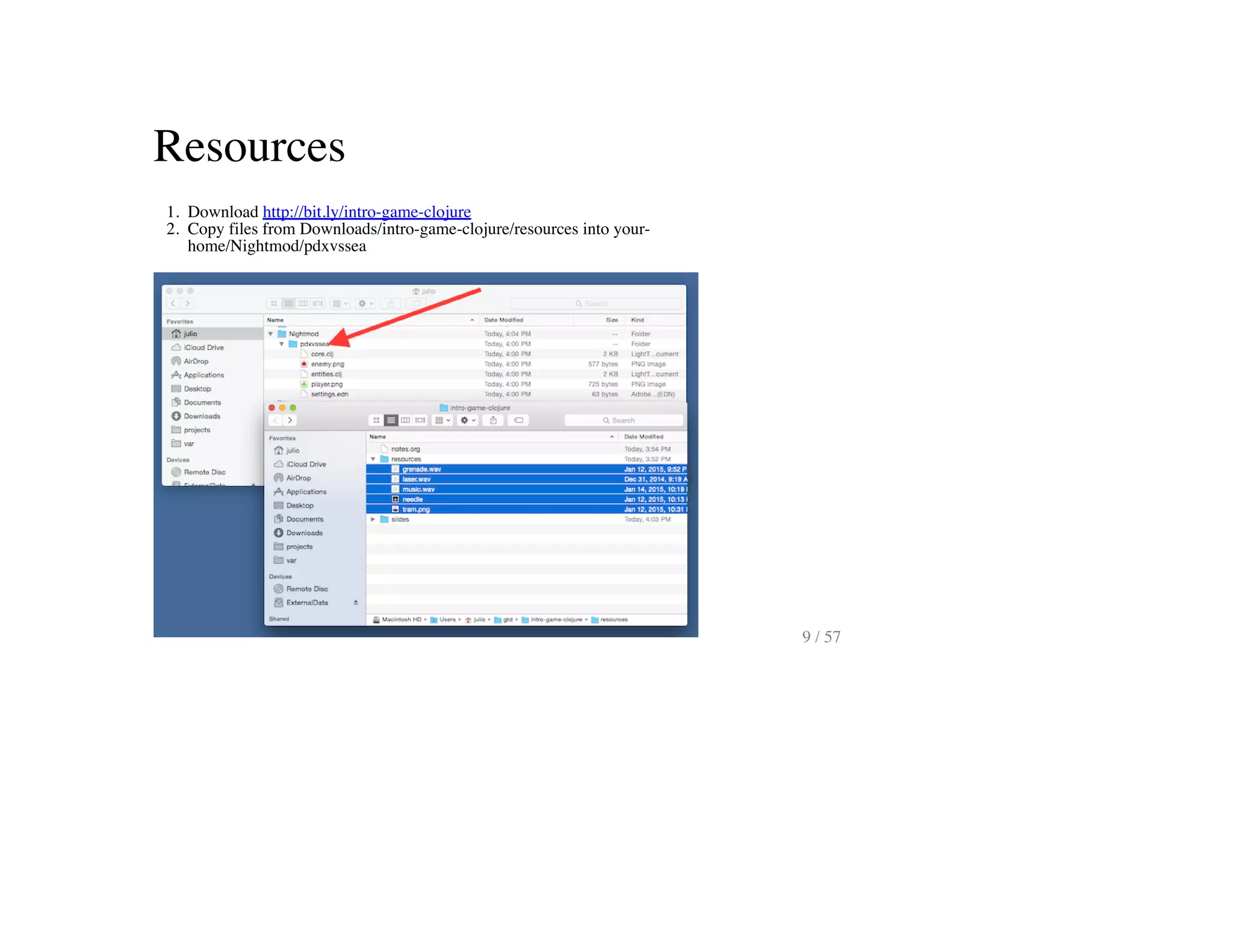
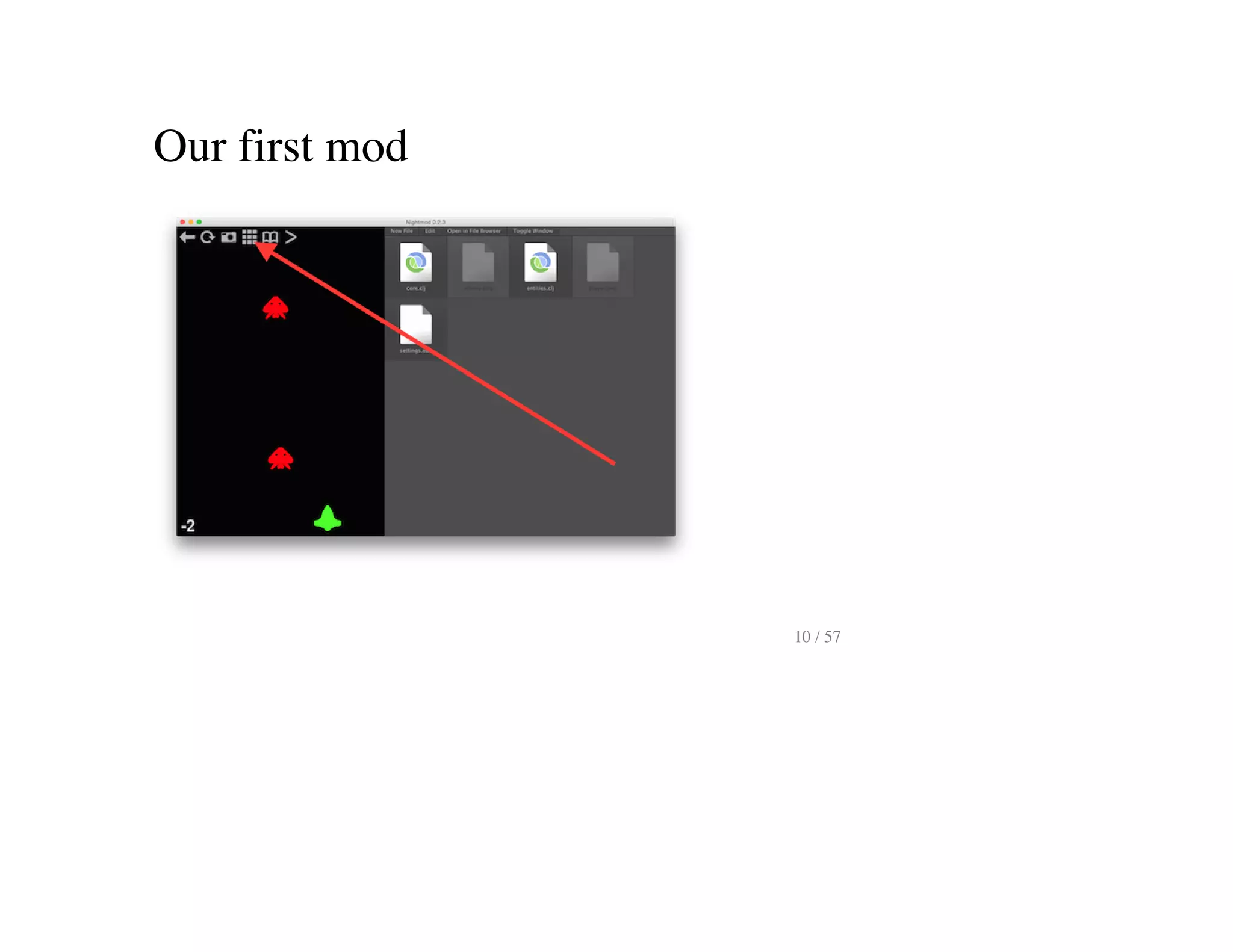
![Change Player
1. Open core.clj go to line 25.
2. Change "player.png" to "tram.png"
3. Save the file
(defscreen main-screen
:on-show
(fn [screen entities]
(update! screen :renderer (stage) :camera (orthographic))
(add-timer! screen :spawn-enemy 0 2)
(assoc (texture "player.png") ;; make this "tram.png"
:player? true
:x (/ (game :width) 2)
:y 10
:width 64
:height 64))
11 / 57](https://image.slidesharecdn.com/introtoprogramminggameswithclojure-150130000941-conversion-gate01/75/Intro-to-programming-games-with-clojure-11-2048.jpg)
![Change the enemy
1. Open entities.clj
2. Go to line 57
3. Change "enemy.png" to "needle.png"
(defn create-enemy
"Returns an enemy at a random position."
[]
(assoc (texture "enemy.png") ;; make this "needle.png"
:enemy? true
:x (rand (game :width))
:y (game :height)
:width 6 4
:height 64))
12 / 57](https://image.slidesharecdn.com/introtoprogramminggameswithclojure-150130000941-conversion-gate01/75/Intro-to-programming-games-with-clojure-12-2048.jpg)
![Change the missile
Starts on line 24 in entities.clj
(defn create-missile
"Returns a missile at the same x position as the mouse."
[]
(assoc (shape :filled
:set-color (color :blue) ;; make :red
:circle 0 0 10) ;; :ellipse 0 0 10 50
:missile? true
:x (game :x)
:y 50 ;; make 70
:width 10
:height 10)) ;; make 50
13 / 57](https://image.slidesharecdn.com/introtoprogramminggameswithclojure-150130000941-conversion-gate01/75/Intro-to-programming-games-with-clojure-13-2048.jpg)
![Play a sound when the missile
fires
(defn create-missile
"Returns a missile at the same x position as the mouse."
[]
(sound "laser.wav" :play) ;; Add this
(assoc (shape :filled
:set-color (color :red)
:ellipse 0 0 10 70)
:missile? true
:x (game :x)
:y 70
:width 20
:height 70))
14 / 57](https://image.slidesharecdn.com/introtoprogramminggameswithclojure-150130000941-conversion-gate01/75/Intro-to-programming-games-with-clojure-14-2048.jpg)
![Play background music
Back in core.clj around line 21
(defscreen main-screen
:on-show
(fn [screen entities]
(sound "music.wav" :loop) ;; Add this
(update! screen :renderer (stage) :camera (orthographic))
(add-timer! screen :spawn-enemy 0 2)
(assoc (texture "tram.png")
:player? true
:x (/ (game :width) 2)
:y 10
:width 64
:height 64))
...
*Originally called http://ccmixter.org/files/djlang59/37792
15 / 57](https://image.slidesharecdn.com/introtoprogramminggameswithclojure-150130000941-conversion-gate01/75/Intro-to-programming-games-with-clojure-15-2048.jpg)
![Silence the background music
(defscreen main-screen
:on-show
(fn [screen entities]
;; (sound "music.wav" :loop)
(update! screen :renderer (stage) :camera (orthographic))
(add-timer! screen :spawn-enemy 0 2)
(assoc (texture "tram.png")
:player? true
:x (/ (game :width) 2)
:y 10
:width 64
:height 64))
...
16 / 57](https://image.slidesharecdn.com/introtoprogramminggameswithclojure-150130000941-conversion-gate01/75/Intro-to-programming-games-with-clojure-16-2048.jpg)
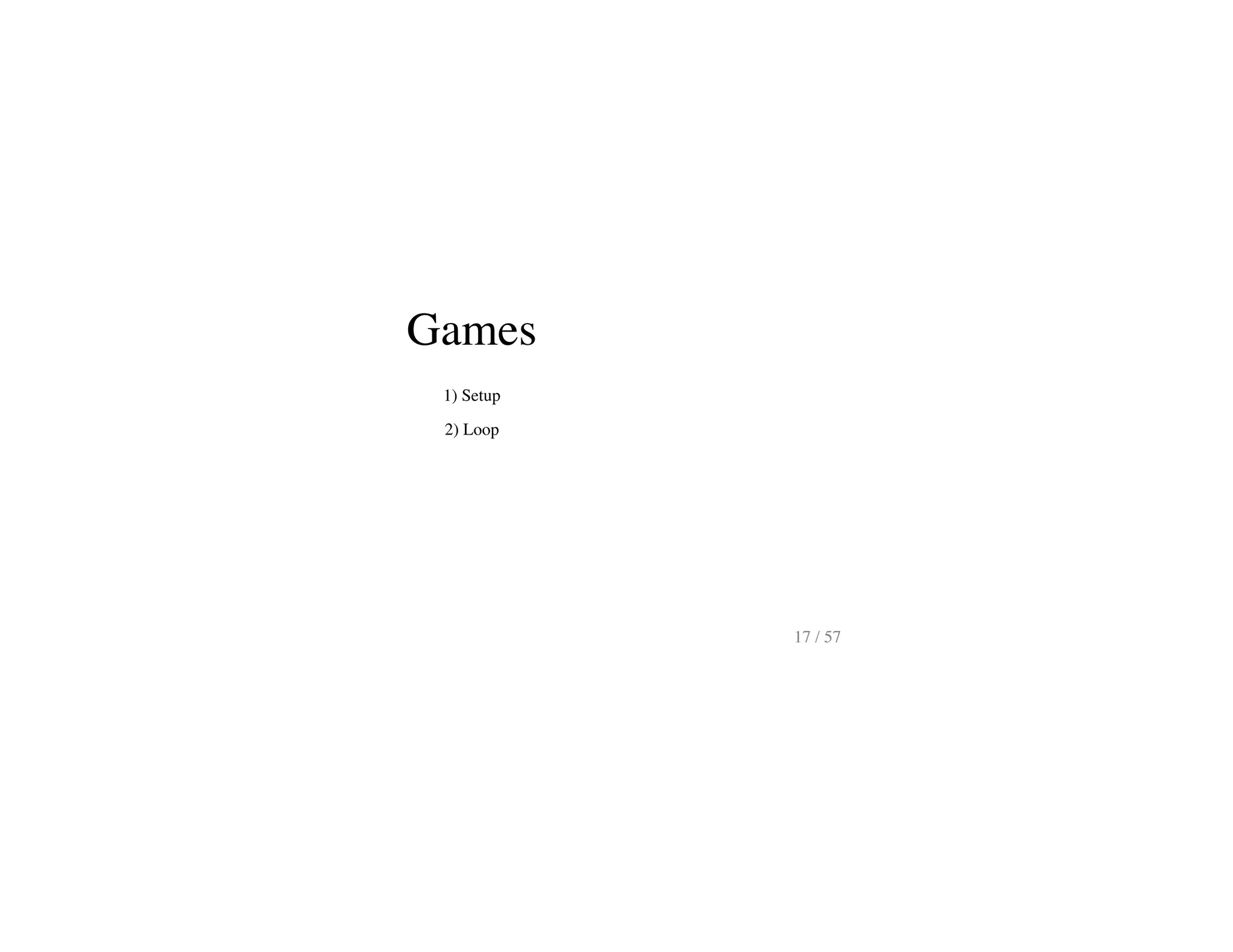
![Setup
core.clj line 20
(defscreen main-screen
:on-show
(fn [screen entities]
(update! screen :renderer (stage) :camera (orthographic))
(add-timer! screen :spawn-enemy 0 2)
(assoc (texture "tram.png")
:player? true
:x (/ (game :width) 2)
:y 10
:width 64
:height 64))
...
18 / 57](https://image.slidesharecdn.com/introtoprogramminggameswithclojure-150130000941-conversion-gate01/75/Intro-to-programming-games-with-clojure-18-2048.jpg)
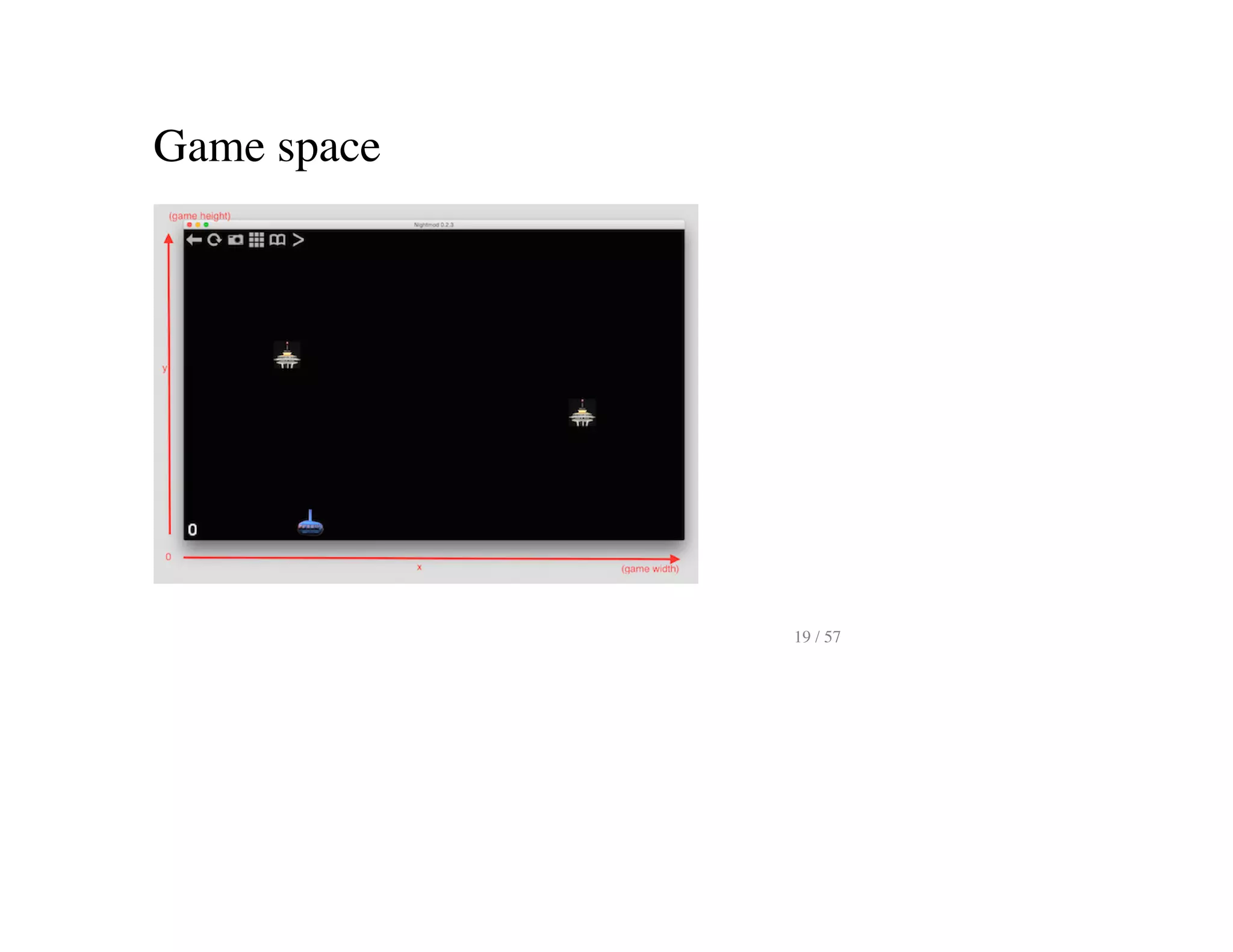
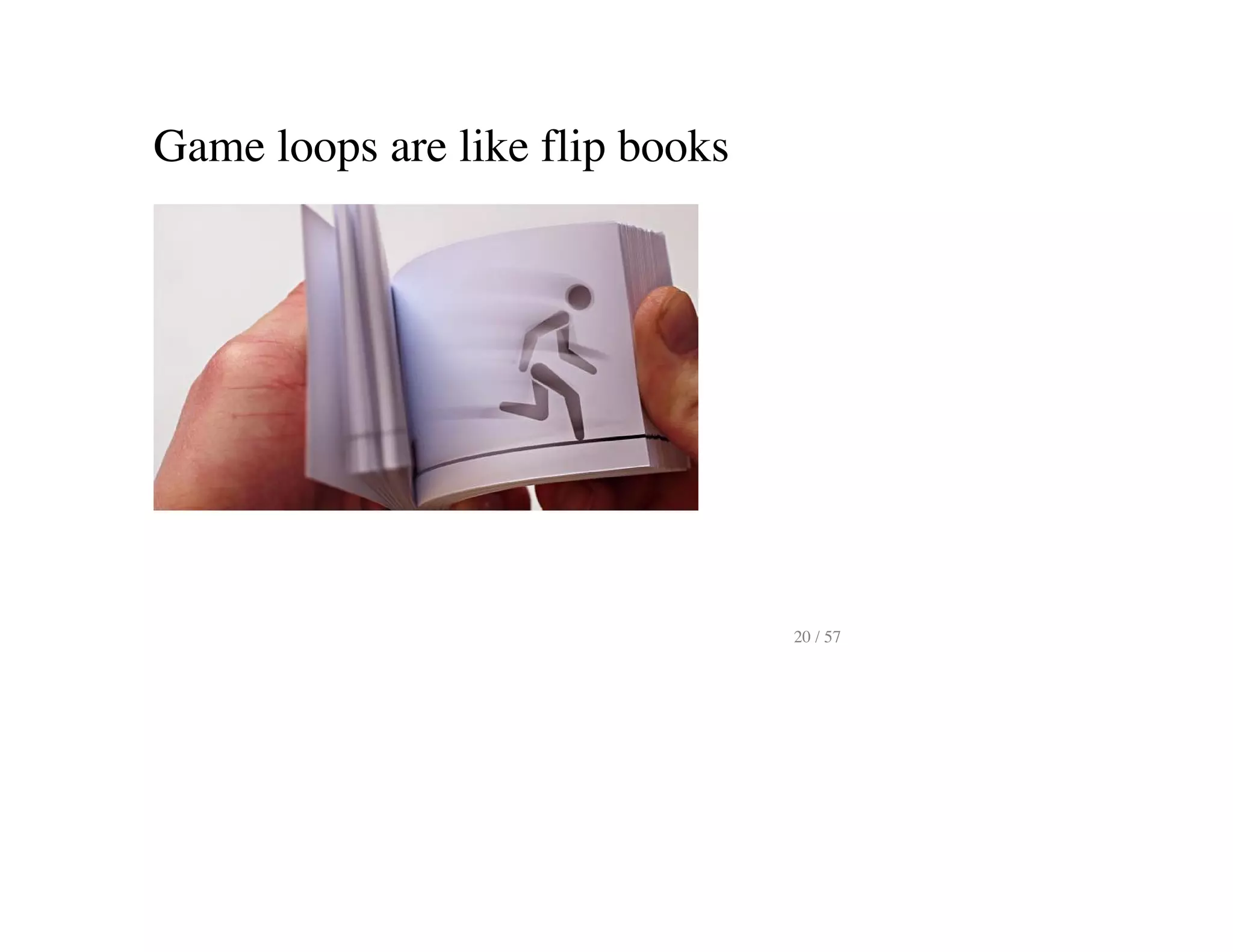
![The game loop - Hollywood
principle
Don't call us we'll call you.
Every time its time to draw a new screen :on-render (line 32) is called
:on-render
(fn [screen entities]
(clear!)
(->> entities
(move-missiles)
(move-enemies)
(update-score!)
(remove-missiles)
(remove-enemies)
(remove :remove?)
(render! screen)))
21 / 57](https://image.slidesharecdn.com/introtoprogramminggameswithclojure-150130000941-conversion-gate01/75/Intro-to-programming-games-with-clojure-21-2048.jpg)
![Move missiles
entities.clj line 37
(defn move-missiles
"Moves the missiles up."
[entities]
(for [e entities]
(if (:missile? e)
(assoc e :y (+ (:y e) 5))
e)))
22 / 57](https://image.slidesharecdn.com/introtoprogramminggameswithclojure-150130000941-conversion-gate01/75/Intro-to-programming-games-with-clojure-22-2048.jpg)
![Move enemies
entities.clj line 65
(defn move-enemies
"Moves the enemies down."
[entities]
(for [e entities]
(if (:enemy? e)
(assoc e :y (- (:y e) 3))
e)))
23 / 57](https://image.slidesharecdn.com/introtoprogramminggameswithclojure-150130000941-conversion-gate01/75/Intro-to-programming-games-with-clojure-23-2048.jpg)
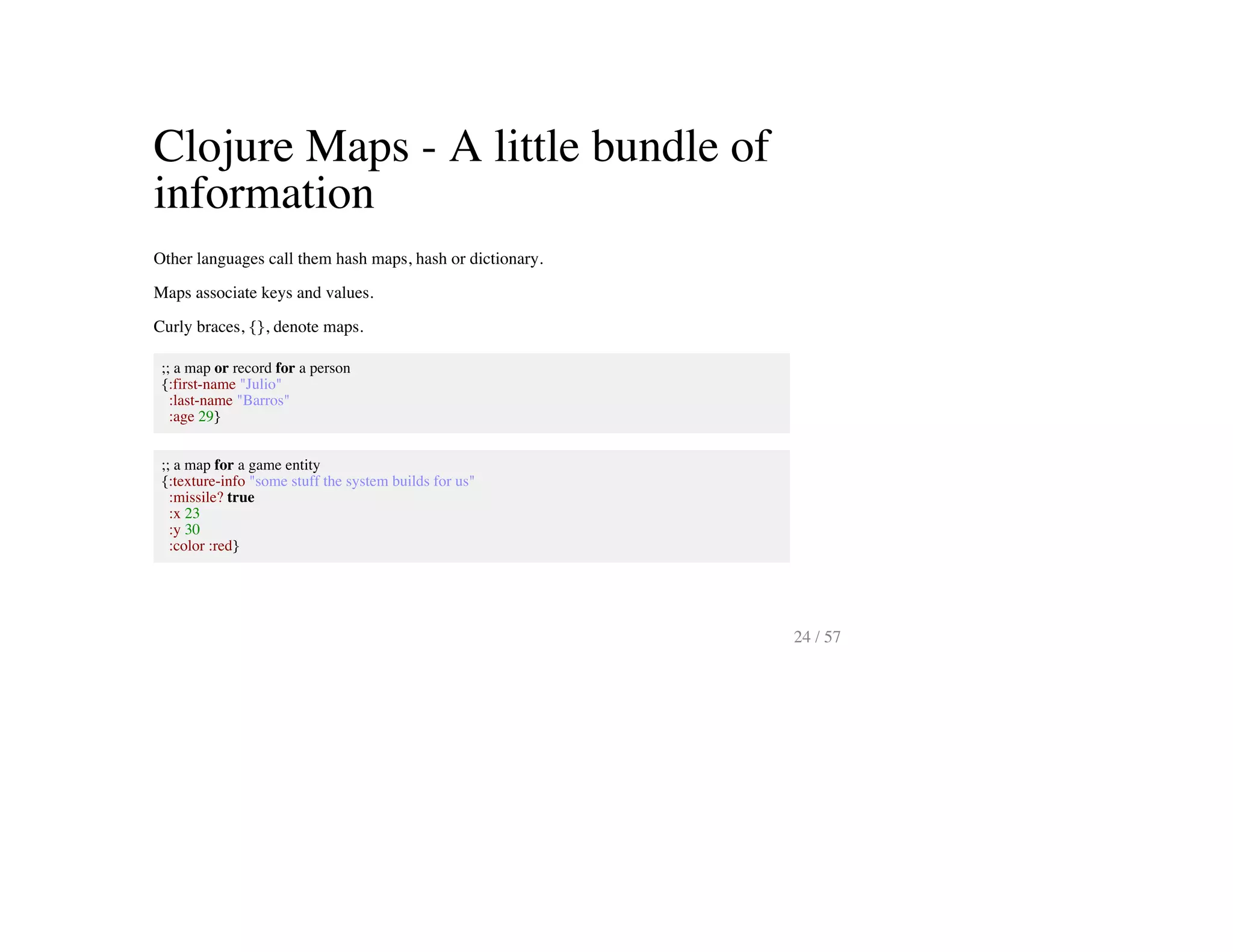
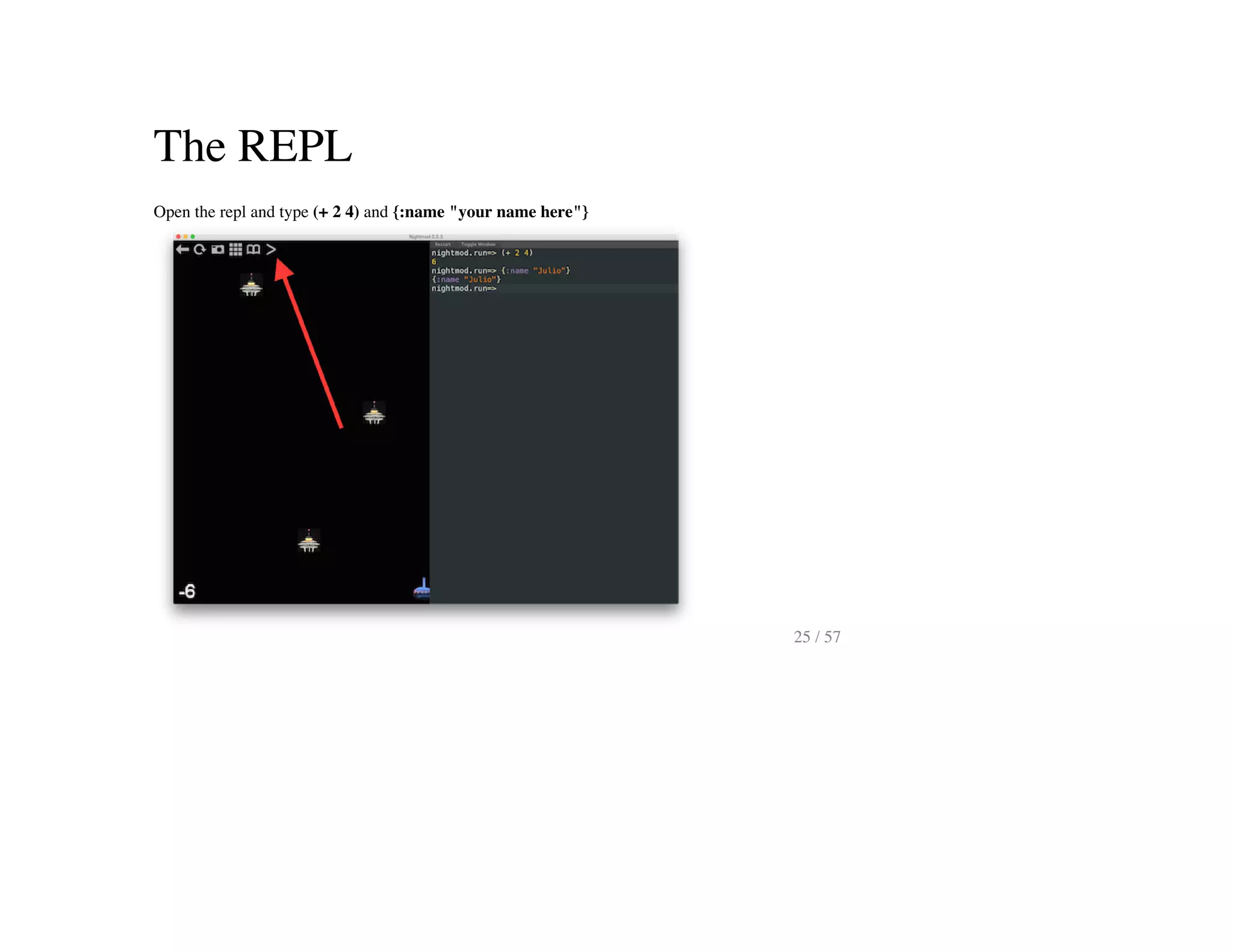
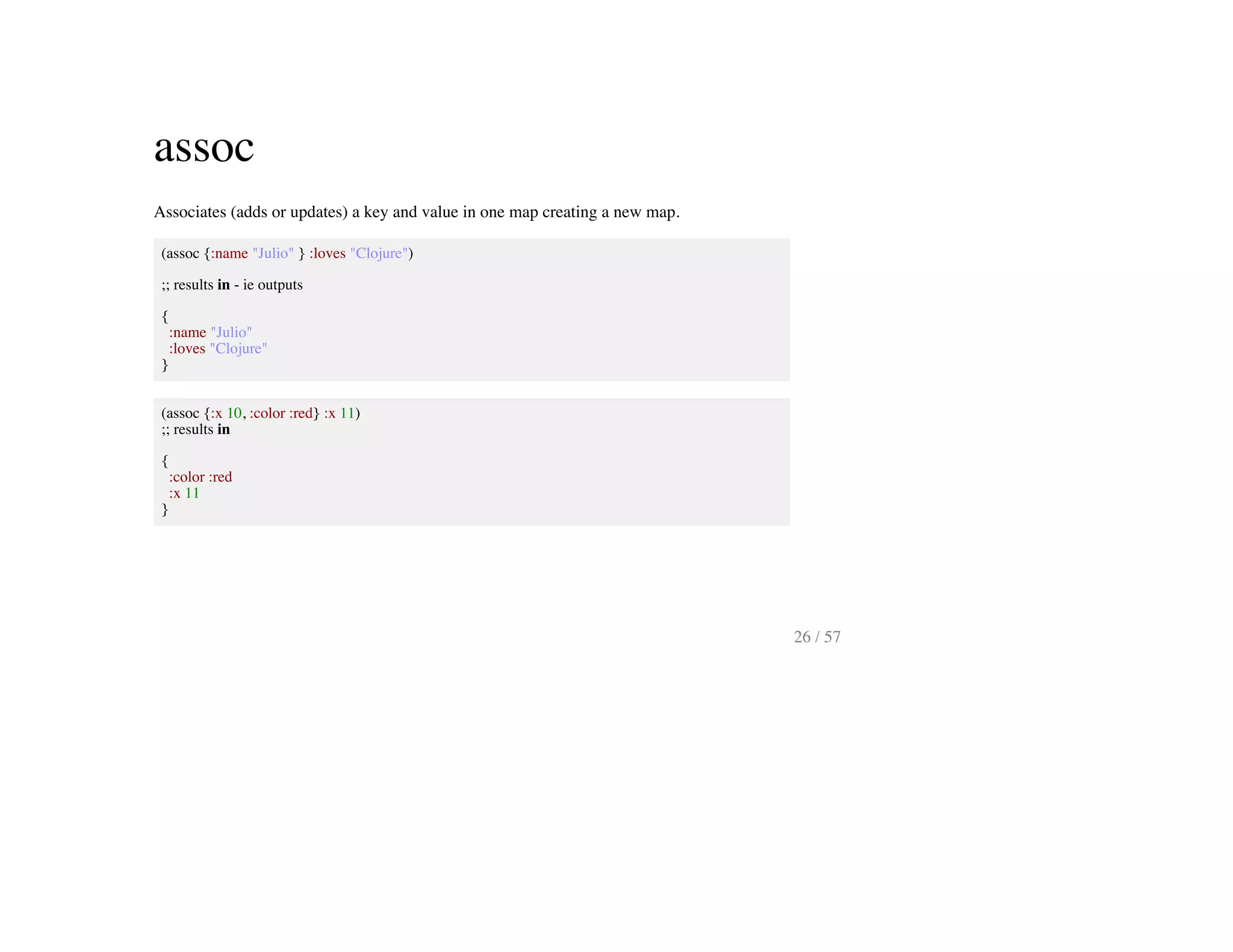
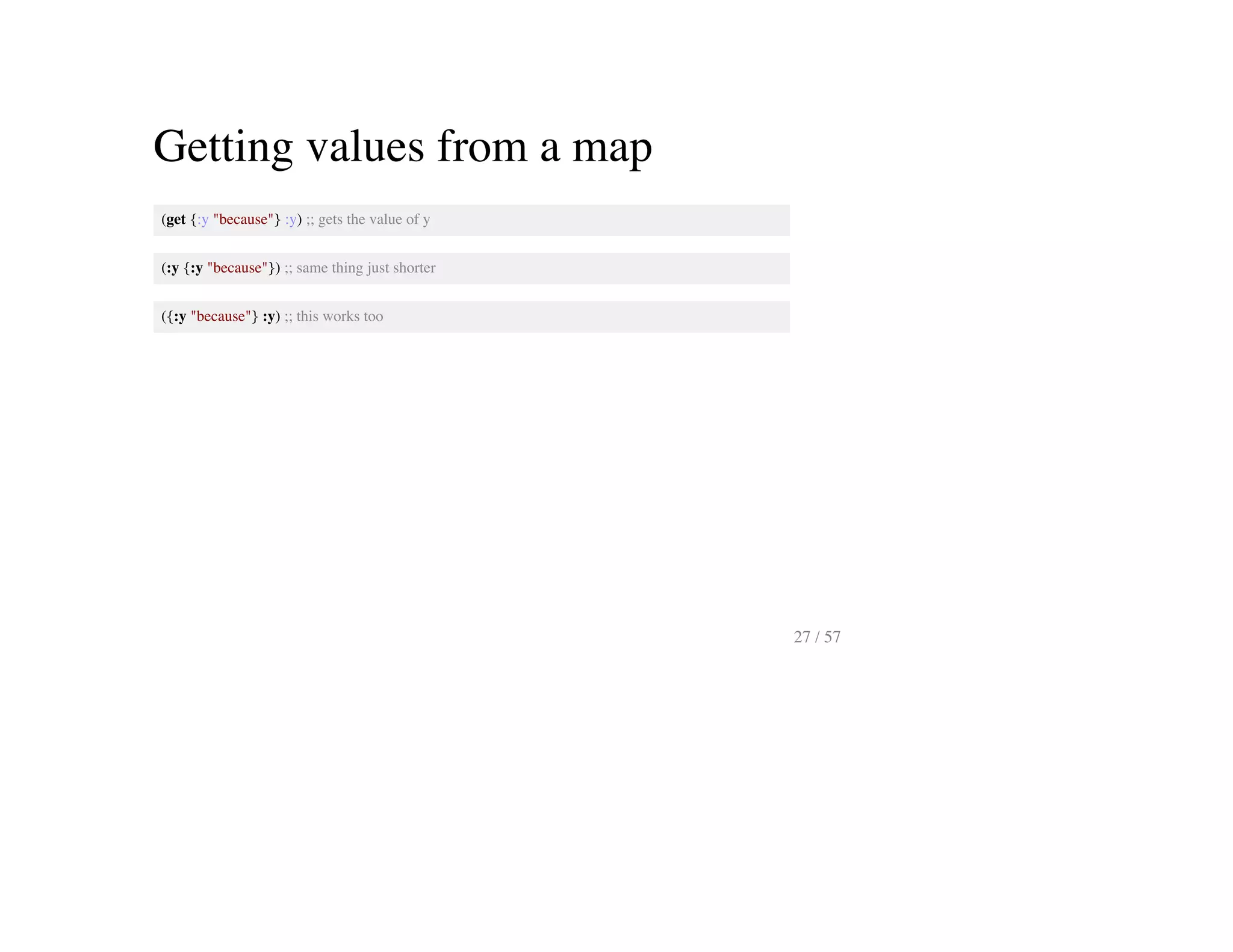
![What's with all those round ()
things?
Parentheses (round braces) denote lists. Lists are a sequence of things.
The special thing about lists is that usually the first item is executed.
(action argument1 argument2)
(function parameter1 parameter2)
(+ 3 4)
(assoc e :x 33)
(assoc {:x 22, :color :red} :x 33)
quote or ' keeps the list from being executed
'(1 2 3) ;; [1 2 3] more common
28 / 57](https://image.slidesharecdn.com/introtoprogramminggameswithclojure-150130000941-conversion-gate01/75/Intro-to-programming-games-with-clojure-28-2048.jpg)
![What's up with the square []
things?
Square brackets, [] denote a vector (array). Vectors are also a sequence.
[1 2 3]
[1 2 [3 4]]
(count [5 5 5])
=> 3
(get [1 2 3] 1) ;; Note: zero based.
=> 2
You can have any length vector (or list) made up of any "type"
[3 {:name "Joe"} [1 2 3] '(1 2 [3 5])]
'(3 {:name "Joe"} [1 2 3] '(1 2 [3 5]))
29 / 57](https://image.slidesharecdn.com/introtoprogramminggameswithclojure-150130000941-conversion-gate01/75/Intro-to-programming-games-with-clojure-29-2048.jpg)
![Other interesting types
"I'm a string" ;; strings
:name ;; keyword
3 ;; integer
3.0 ;; double
;; Note: 3.0 is different than "3.0"
0.5 ;; must start with a number
{} ;; map
[] ;; vectors
() ;; lists
#{} ;; set - unordered collection with no duplicates
30 / 57](https://image.slidesharecdn.com/introtoprogramminggameswithclojure-150130000941-conversion-gate01/75/Intro-to-programming-games-with-clojure-30-2048.jpg)
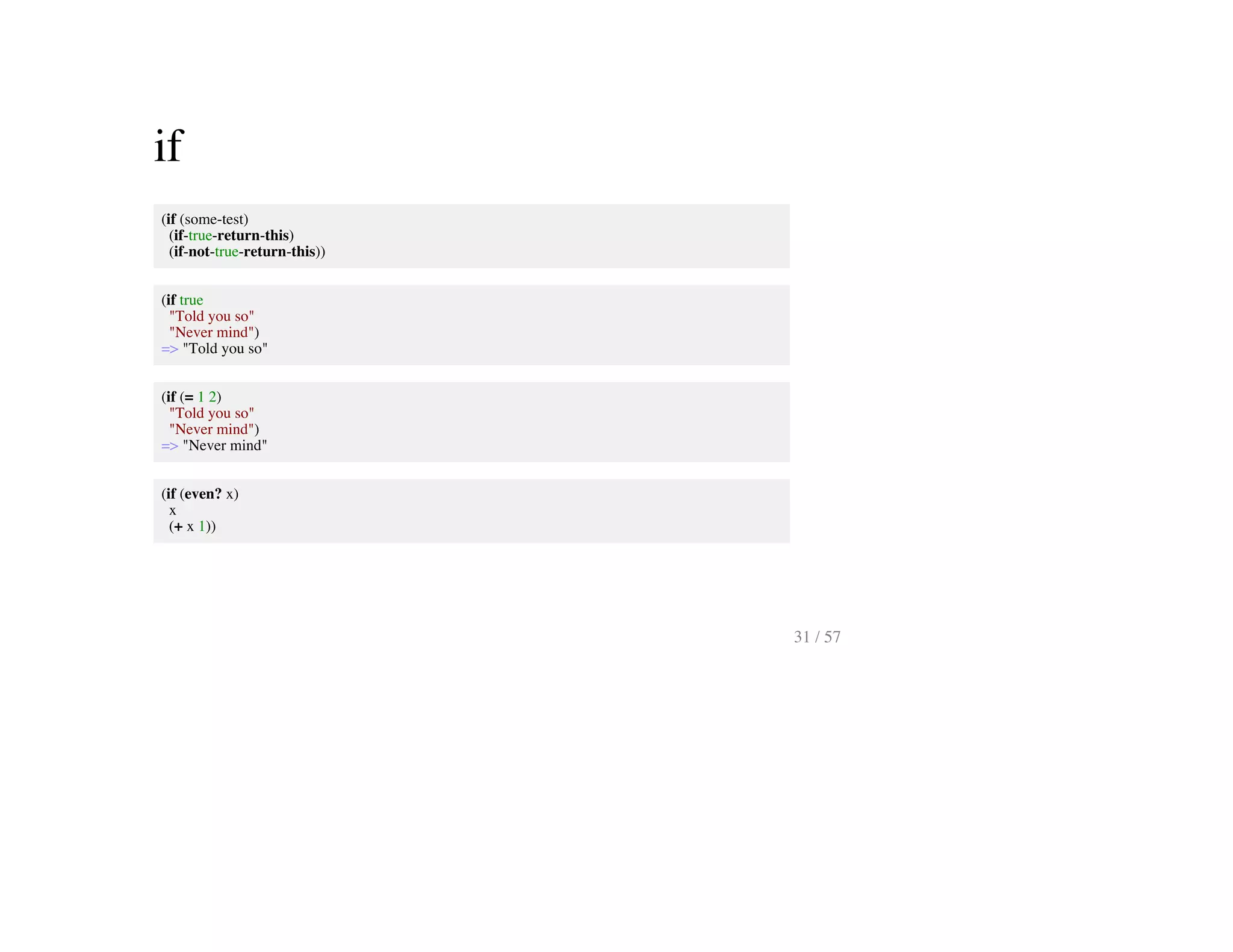
![for
Walks through vector/sequence giving each element the name "e" and using it in the steps
that follow.
"e" can be any name.
Returns a vector.
(for [e [1 2 3]]
(+ e e))
=> (2 4 6)
(for [current-n [1 2 3]]
(even? current-n))
=> (false true false)
(for [e entities]
(if (:missile? e)
(assoc e :y (+ (:y e) 5))
e))
32 / 57](https://image.slidesharecdn.com/introtoprogramminggameswithclojure-150130000941-conversion-gate01/75/Intro-to-programming-games-with-clojure-32-2048.jpg)
![Functions
Takes zero or more input parameters and returns a single value.
The return value could be a list or map or vectors of multiple things.
Returns the result of the last expression executed.
(defn my-function-name
"A documentation string"
[param1 param2]
(functionA param1)
(functionB param1 param2))
(defn increment
"Adds one to the parameter"
[a-number]
(+ 1 a-number))
(increment 3)
=> 4
33 / 57](https://image.slidesharecdn.com/introtoprogramminggameswithclojure-150130000941-conversion-gate01/75/Intro-to-programming-games-with-clojure-33-2048.jpg)
![Move enemies
(defn move-enemies
"Moves the enemies down."
[entities]
(for [e entities]
(if (:enemy? e)
(assoc e :y (- (:y e) 3))
e)))
(move-enemies [{:enemy? true :y 100} {:enemy? false :y 25} {:missile? true :y 50}])
=> ({:y 97, :enemy? true} {:y 25, :enemy? false} {:y 50, :missile? true})
34 / 57](https://image.slidesharecdn.com/introtoprogramminggameswithclojure-150130000941-conversion-gate01/75/Intro-to-programming-games-with-clojure-34-2048.jpg)
![Create an enemy
(defn create-enemy
"Returns an enemy at a random position."
[]
(assoc (texture "needle.png")
:enemy? true
:x (rand (game :width))
:y (game :height)
:width 64
:height 64))
(create-enemy)
{:object "... some stuff about com.badlogic.gdx.graphics.g2d.TextureRegion"
:height 64,
:width 64,
:y 965,
:x 173.37581878372418,
:enemy? true}
35 / 57](https://image.slidesharecdn.com/introtoprogramminggameswithclojure-150130000941-conversion-gate01/75/Intro-to-programming-games-with-clojure-35-2048.jpg)
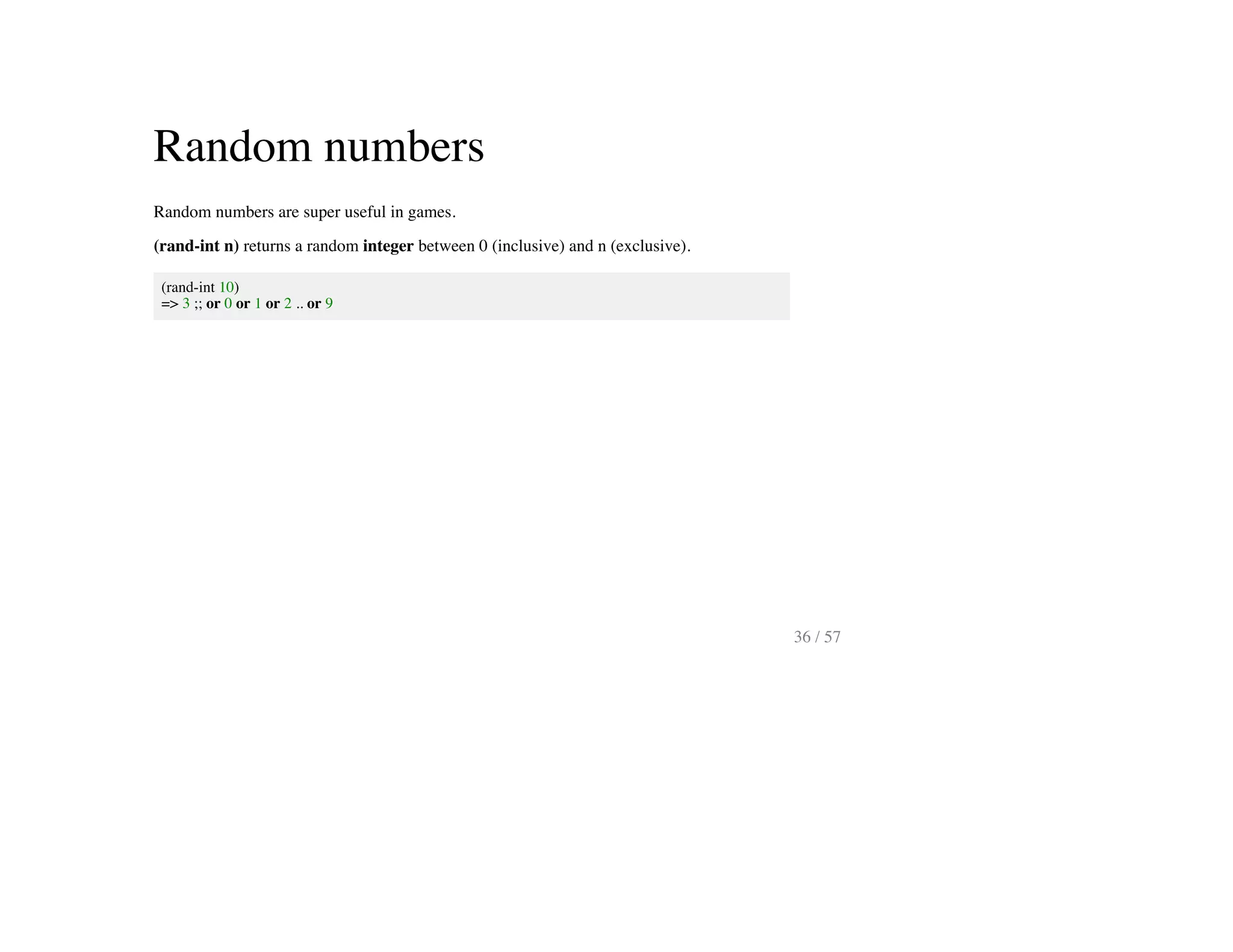
![Exercise: Our own Function -
choose-one
Write a function called choose-one that randomly chooses one element from a vector
(choose-one [3 6]) chooses either 3 or 6 randomly. Put the function at the top of entities.clj
Things to think about:
1. How do you know how many things are in the vector?
2. How do you pick an index between 0 and the last index in the vector?
3. How do you get the item in the vector at that index?
37 / 57](https://image.slidesharecdn.com/introtoprogramminggameswithclojure-150130000941-conversion-gate01/75/Intro-to-programming-games-with-clojure-37-2048.jpg)
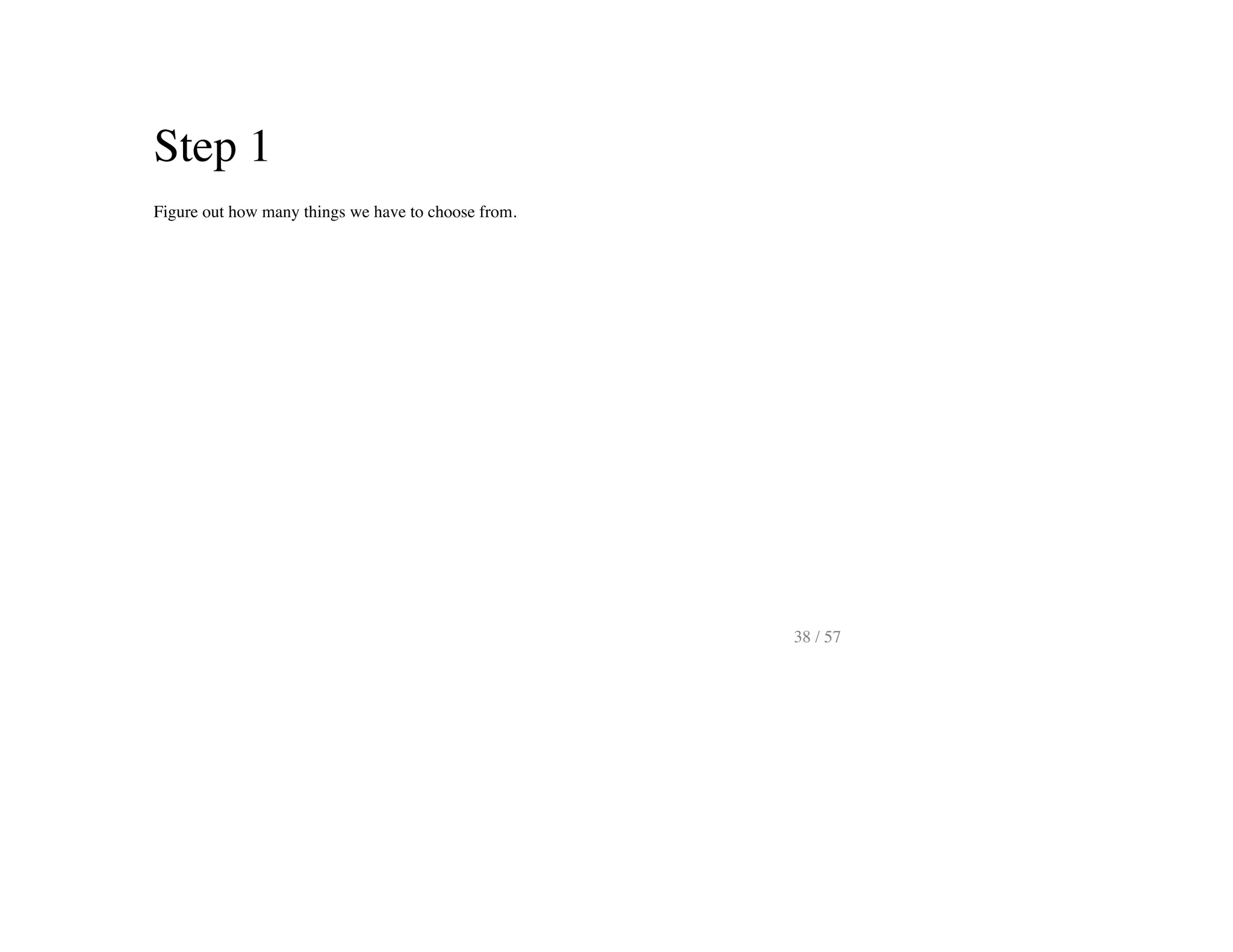
![Step 1
Figure out how many things we have to choose from.
(defn choose-one
"Pick and return one thing from v. Well just the number of things in v."
[v]
(count v))
39 / 57](https://image.slidesharecdn.com/introtoprogramminggameswithclojure-150130000941-conversion-gate01/75/Intro-to-programming-games-with-clojure-39-2048.jpg)
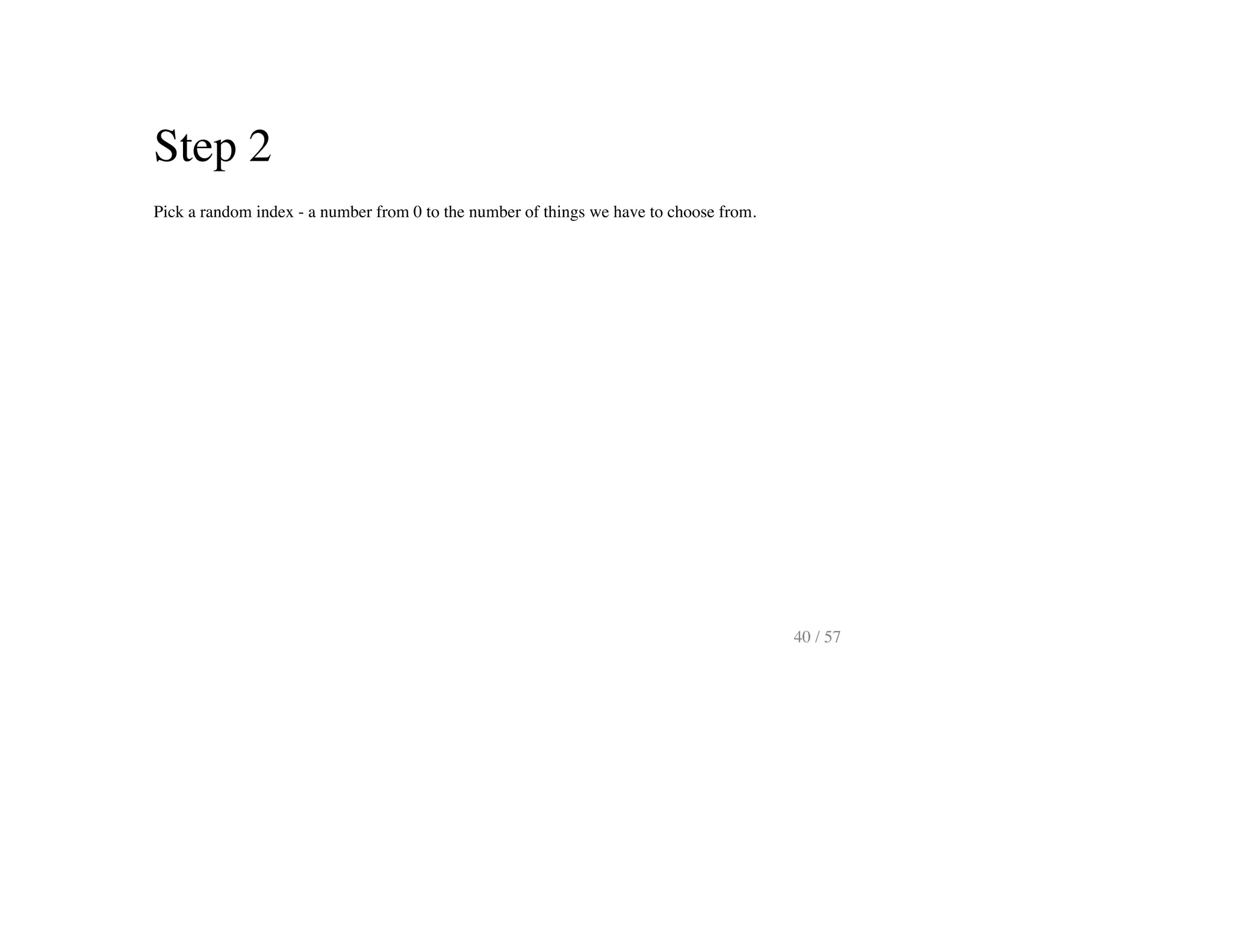
![Step 2
Pick a random index - a number from 0 to the number of things we have to choose from.
(defn choose-one
"Pick and return one thing from v. Well a random valid index into v."
[v]
(rand-int (count v)))
41 / 57](https://image.slidesharecdn.com/introtoprogramminggameswithclojure-150130000941-conversion-gate01/75/Intro-to-programming-games-with-clojure-41-2048.jpg)
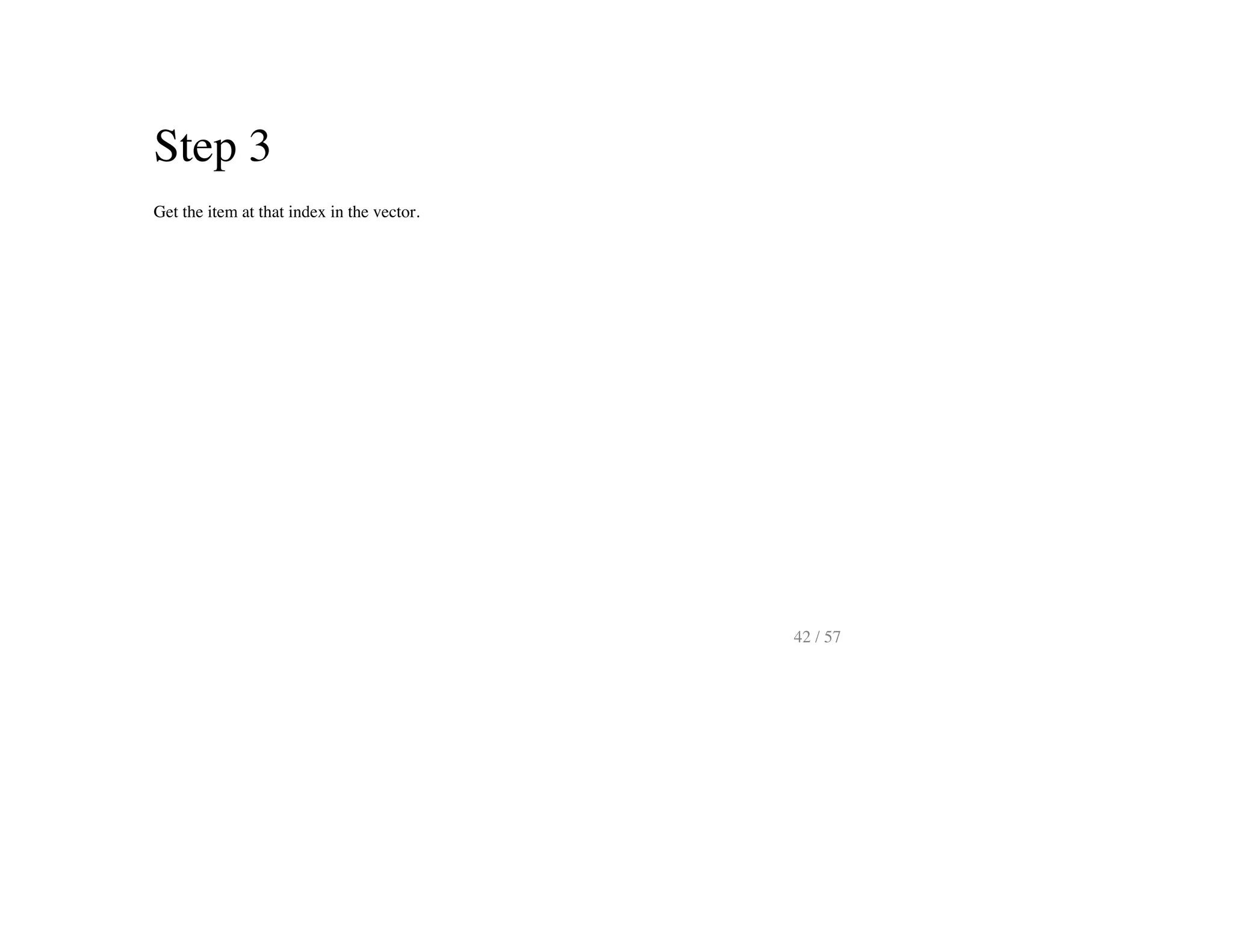
![A solution
Get the item at that index in the vector
(defn choose-one
"Pick and return one thing from v."
[v]
(get v (rand-int (count v))))
43 / 57](https://image.slidesharecdn.com/introtoprogramminggameswithclojure-150130000941-conversion-gate01/75/Intro-to-programming-games-with-clojure-43-2048.jpg)
![Use choose-one to pick different
enemies
(defn create-enemy
"Returns an enemy at a random position."
[]
(assoc (texture (choose-one ["enemy.png","needle.png"]))
:enemy? true
:x (rand (game :width))
:y (game :height)
:width 6 4
:height 64))
44 / 57](https://image.slidesharecdn.com/introtoprogramminggameswithclojure-150130000941-conversion-gate01/75/Intro-to-programming-games-with-clojure-44-2048.jpg)
